Paul van Yperen's Blog, page 77
August 19, 2023
Gérard Depardieu
Gérard Depardieu (1948) with his trademark bulbous nose is France’s biggest male film star. He developed from France’s young male sensation in 1974 into a bulging and controversial but very talented character actor. Since 1967, he completed over 170 films and received more César nominations than anyone else. Since the critical acclaim for his role as Cyrano de Bergerac, he achieved worldwide stardom.

French postcard in the Signes du Zodiaque by Editions F. Nugeron, no. 16. Caption: Capricorn.
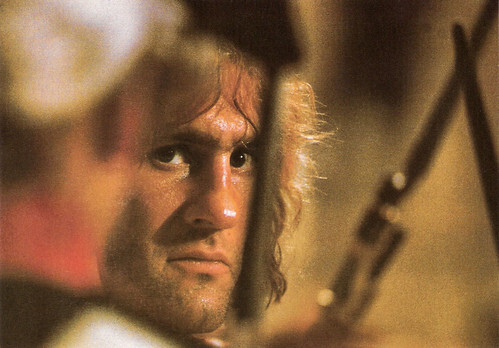
French postcard by Editions La Malibran, Nancy, in the collection Cinéma Couleur, no. MC 16. Photo: Georges Pierre. Gérard Depardieu in Danton (Andrzej Wajda, 1983).
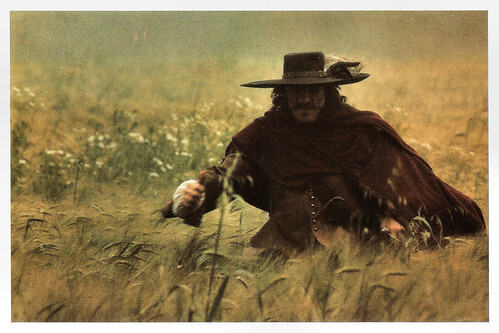
British postcard by Artificial Eye. Gérard Depardieu in Cyrano de Bergerac (Jean-Paul Rappeneau, 1990).
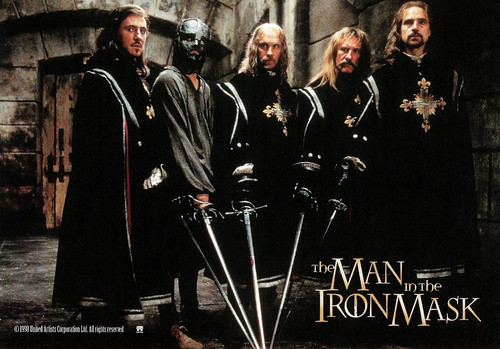
French postcard by Sonis, no. C. 854. Photo: United Artists. Gabriel Byrne, Leonardo DiCaprio , John Malkovich, Gérard Depardieu and Jeremy Irons in The Man in the Iron Mask (Randall Wallace, 1998).
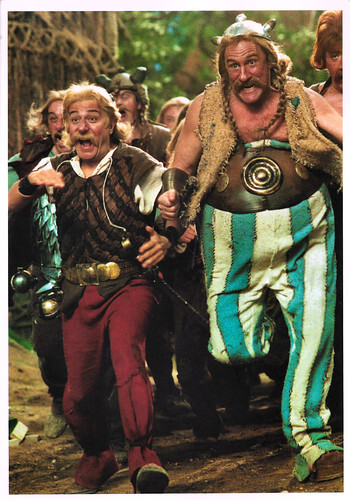
Big Happy New Year card by Pathé. Photo: Christian Clavier and Gérard Depardieu in Astérix & Obélix contre César/Asterix and Obelix Take on Caesar (Claude Zidi, 1999).
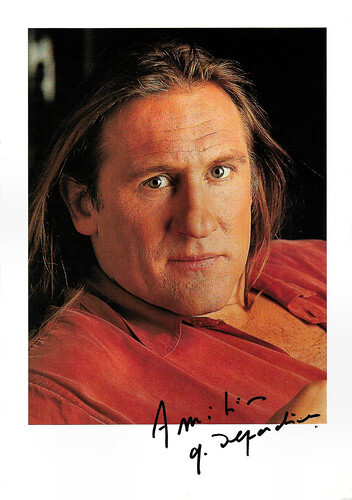
Vintage autograph card.
Whimsical, aimless thug
Gérard Xavier Marcel Depardieu was born in working-class Châteauroux, France in 1948. He is one of five children of Anne Depardieu-Marillier called ‘la Liette’ and René ‘le Dédé’ Depardieu, a metal worker and volunteer fireman. As a boy, Depardieu spent more time on the street than in the classroom. According to Tracie Cooper at AllMovie : “At twelve years old, he dropped out of school and hitchhiked across Europe on an informal tour funded primarily by the profits of stolen cars and assorted black-market products. Depardieu would likely have continued in his juvenile delinquency were it not for a friend who was attending drama school in Paris.”
So in 1966, Depardieu decided to enrol at the École d'art dramatique too. He began acting in the new comedy theatre Café de la Gare, where he met actors Patrick Dewaere , Coluche , and Miou-Miou . He made his film debut in the short Le beatnik et le minet/The beatnik and pussy (Roger Leenhardt, 1967). More minor film parts followed. In 1970, he married Élisabeth Guignot, with whom he had two children, actor Guillaume (1971–2008) and actress Julie (1973).
In 1972, he appeared in Nathalie Granger (Marguerite Duras, 1972) with Lucia Bosé . The following year he played in the Horror film Au rendez-vous de la mort joyeuse/At the Meeting with Joyous Death (1973), directed by Juan Luis Buñuel, the son of Luis Buñuel. His breakout film was Bertrand Blier's comedy Les valseuses/Going Places (1974), in which he co-starred with Patrick Dewaere and Miou-Miou . Les valseuses was the 3rd highest grossing film of the year in France, and his part as a whimsical, aimless thug turned him into France’s young male sensation.
In the following years, he went on to become one of France's most renowned actors with films like Vincent, François, Paul... et les autres/Vincent, François, Paul and the Others (Claude Sautet, 1974) with Yves Montand , Sept morts sur ordonnance/Seven Deaths by Prescription (Jacques Rouffio, 1975) starring Michel Piccoli , and Maîtresse/mistress (Barbet Schroeder, 1976) starring Bulle Ogier. The latter provoked controversy in the United Kingdom and the United States because of its graphic depictions of sado-masochism. Then he was the co-star of Robert de Niro in the Italian epic film Novecento/1900 (Bernardo Bertolucci, 1976). The film chronicles the lives of two men during the political turmoil that took place in Italy in the first half of the 20th century. Also remarkable was La Dernière femme/The Last Woman (Marco Ferreri, 1976) starring Ornella Muti , in which his character mutilates himself.
Another success was the gritty romantic comedy Préparez vos mouchoirs/Get Out Your Handkerchiefs (Bertrand Blier, 1978), which received the Academy Award for Best Foreign Language Film. Other memorable films were Mon oncle d'Amérique/My American Uncle (Alain Resnais, 1980), which won the Grand Prix and the FIPRESCI prizes at the 1980 Cannes Film Festival, the drama Loulou (Maurice Pialat, 1980) with Isabelle Huppert , and Le Dernier Métro/The Last Metro (François Truffaut, 1980) starring Catherine Deneuve . The latter film, set in a small Parisian theatre during the time of the French received Oscar and Golden Globe nominations for Best Foreign Film and won ten Césars. Depardieu himself was awarded for his performance as a resistance fighter. Le Dernier Métro was one of the most popular films of the year in France and one of Truffaut's most successful productions abroad.
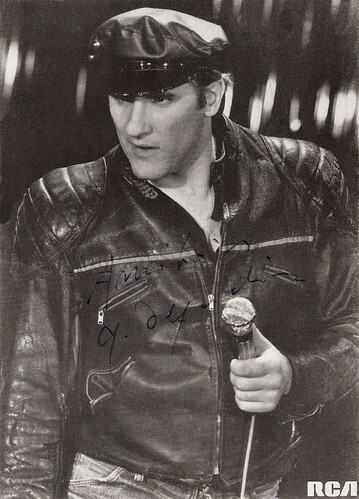
French postcard by RCA. Photo: GAMMA. Promotion card for his album 'Ils ont dit moteur...' (1980).
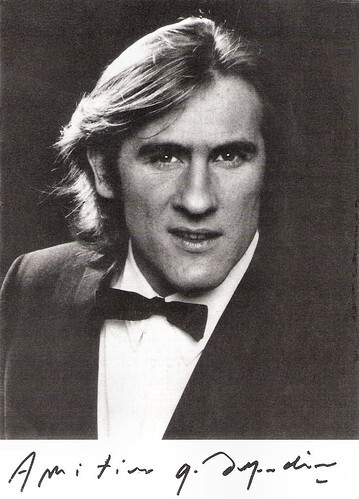
French postcard by La Roue Tourne, Paris.
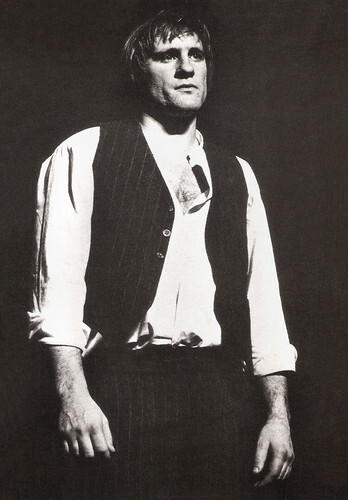
French postcard by Humour a la Carte, Paris, no. 3442. Photo: Ilana Ben-Ari.
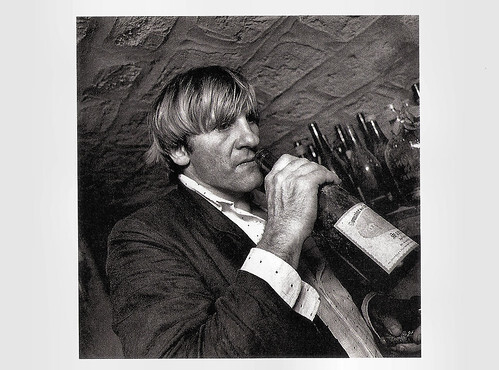
Swiss postcard by News Productions, Baulmes, no. 55506. Photo: Pierre-Olivier Deschamps / Agence VU, Paris, 1986.
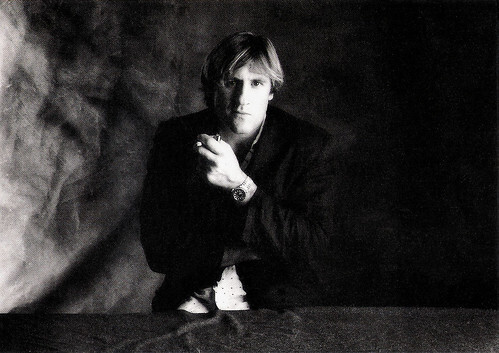
French card with blank back.
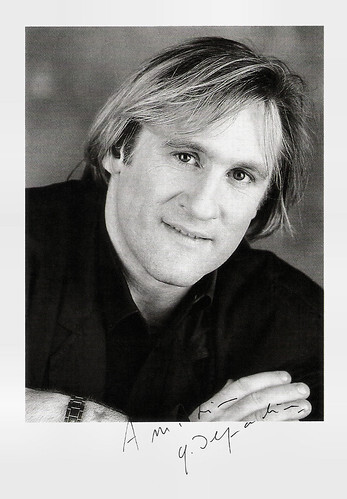
French autograph card with blank back.
Exceptional talent, energy and versatility
During the 1980s Gérard Depardieu’s star continued to rise. Among his most memorable films are Truffaut's final film La femme d'à côté/The Woman Next Door (François Truffaut, 1981), the farce La chèvre/The Goat (Francis Veber, 1981) with Pierre Richard , the medieval drama Le retour de Martin Guerre/The Return of Martin Guerre (1982), and the historical biopic Danton (Andrzej Wajda, 1983).
Ginette Vincendeau writes in Encyclopedia of European Cinema : “Apart from exceptional talent and energy, a key to Depardieu’s success is his versatility. Equally at ease in broad farce and romantic leads, he has been a mainstay of popular cinema.” His international fame grew as a result of his performance as a doomed, hunchbacked farmer in Jean de Florette (Claude Berri, 1986) and Manon des sources (Claude Berri, 1986).
Five years later, he won a César and an Oscar nomination for his starring role in Cyrano de Bergerac (Jean-Paul Rappeneau, 1990). He did not win the Oscar, presumably because Time magazine had run a profile that mistakenly suggested that Depardieu might have ‘participated’ in a rape at the age of nine. The claim was based on an interview carried out 13 years earlier and was the result of an incorrect translation. However, Depardieu crossed over into the American film market by co-starring in Green Card (Peter Weir, 1990).
Ginette Vincendeau: “Like Jean Gabin before him, Depardieu sums up an idealised French masculinity, merging working-class virility with romanticism. Exporting himself has meant losing some of these complexities, since Depardieu’s global stardom is, so far, dependent (as was Maurice Chevalier ’s) on playing a rather clichéd Frenchness as in Green Card, or even Europeanness, as in Ridley Scott’s 1492 Conquest of Paradise (1992).”
In 1992, while separated from Élisabeth Guignot, he had a daughter, Roxanne, with the model Karine Sylla. In 1996 he divorced Élisabeth and began a relationship with actress Carole Bouquet, who was his partner from 1997 to 2005. Remarkable films from this period include Tous les matins du monde/All the mornings of the world (Alain Corneau, 1991), Una pura formalità/A Pure Formality (Giuseppe Tornatore, 1994), and Hamlet (Kenneth Branagh, 1996).
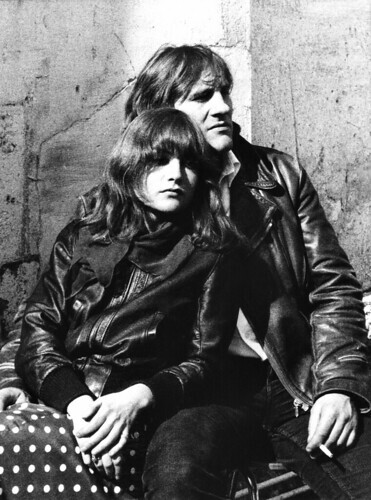
French card. Photo: Isabelle Huppert and Gérard Depardieu in Loulou (Maurice Pialat, 1980).
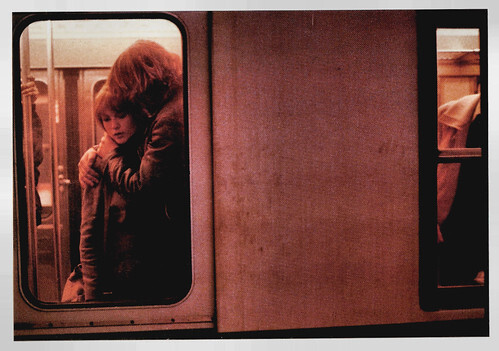
French postcard by Editions La Malibran, Nancy, in the collection Cinéma Couleur, no. MC 39. Publicity still for Loulou (Maurice Pialat, 1979) with Isabelle Huppert.
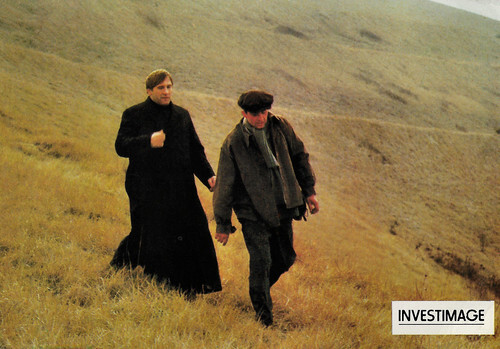
French postcard by F.E.C.V. Photo: Investimage. Gérard Depardieu in Sous le soleil de Satan (Maurice Pialat, 1987).
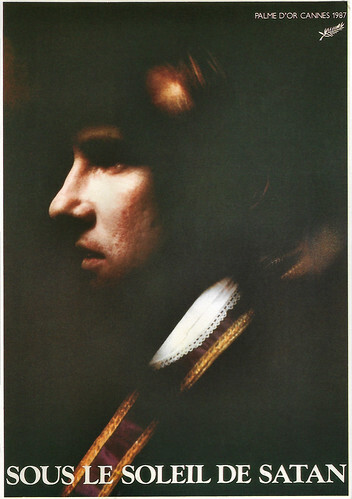
French postcard by Editions Ramsay / F. Nugeron, no. 40. Photo: Gaumont. Gérard Depardieu in Sous le soleil de Satan (Maurice Pialat, 1987). Caption: Palme d'or Cannes 1987.
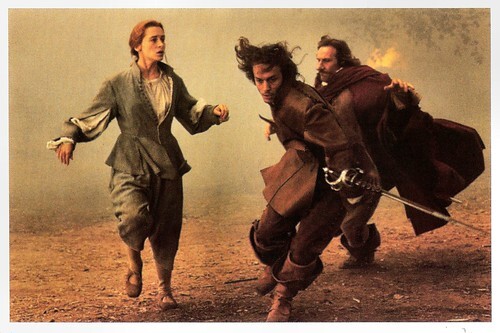
French postcard. Photo: Artificial Eye. Anne Brochet, Vincent Perez and Gérard Depardieu in Cyrano de Bergerac (Jean-Paul Rappeneau, 1990).
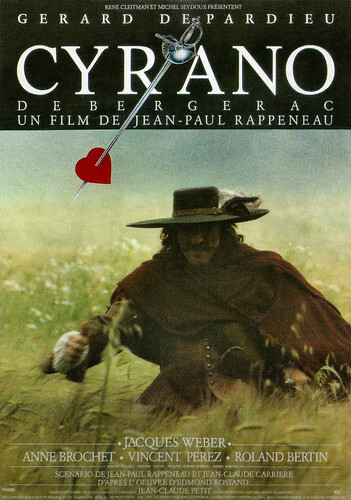
French postcard by Sonis, no. C. 90. French poster for Cyrano de Bergerac (Jean-Paul Rappeneau, 1990) with Gérard Depardieu. Photo: Benoit Berbier. Concept: Serge Fichard, Bruno le Moult.
Obélix
In 1999, Gérard Depardieu played for the first time Obélix in the live-action film Astérix et Obélix contre César/Asterix and Obelix vs. Caesar (Claude Zidi, 1999) with Christian Clavier as Asterix. The film, based on the comic book by René Goscinny, was tremendously successful at the European box offices. There would be three sequels: Astérix & Obélix: Mission Cléopâtre/Asterix & Obelix: Mission Cleopatra (Alain Chabat, 2002), Astérix aux jeux olympiques/Asterix at the Olympic Games (Frédéric Forestier, Thomas Langmann, 2008) and Astérix et Obélix: Au service de Sa Majesté/Astérix and Obélix: God Save Britannia (Laurent Tirard, 2012).
In between he appeared in films as the comedy Le placard/The Closet (Francis Veber, 2001) with Daniel Auteuil, Tais-toi!/Shut Up (Francis Veber, 2003) with Jean Reno , the crime drama 36 Quai des Orfèvres/36 (Olivier Marchal, 2004), the Edith Piaf biopic La môme/La vie en rose (Olivier Dahan, 2007) featuring Marion Cotillard, the crime film L'instinct de mort/Mesrine: Part 1 - Killer Instinct (Jean-François Richet, 2008) and the follow-up L'ennemi public n°1/Mesrine: Part II - Public Enemy #1 (Jean-François Richet, 2008) both starring Vincent Cassel, and the drama À l'origine/In the Beginning (Xavier Giannoli, 2009).
Depardieu attracted attention from the media and legal authorities for his sometimes stormy behaviour. He made a concerted effort to cut back on his alcohol consumption following a heart attack and an emergency quintuple bypass operation, in 2000. In 2003, he officially cut off contact with his son, Guillaume Depardieu when the young man threatened him with a gun and received a suspended prison sentence. Since 2005, he has lived with novelist Clémentine Igou, but in 2006, he had a son, Jean, with Hélène Bizot. Meanwhile Guillaume made headlines for drug abuse, a motorbike crash and a hospital infection contracted during the post-accident operations, eventually leading to the amputation of his leg. At 37, Guillaume died from complications linked to a sudden case of pneumonia.
In August 2012, Depardieu was accused of assault and battery for punching a motorist in Paris. In November 2012, he was arrested for driving while intoxicated after he fell from his scooter. He has been an official resident of Néchin, Belgium since December 2012. French prime minister Jean-Marc Ayrault claimed the reason for the move was to avoid a looming 75% top rate of tax. Depardieu reacted with a public statement he was handing back his French passport. In January 2013, Russian President Vladimir Putin signed an Executive Order granting Russian citizenship to Depardieu. Depardieu soon returned the favour by attacking Putin's critics.
More importantly, he continues to make good films. In La tête en friche/My Afternoons with Margueritte (Jean Becker, 2010) he played an illiterate and lonely man who bonds with an older and well-read woman (Gisèle Casadesus). The comedy Potiche/Trophy Wife (François Ozon, 2010) reunited him with Catherine Deneuve . And he appeared in Life of Pi (Ang Lee, 2012), the TV series Marseille (2016-2018) and Illusions perdues/Lost Illusions (Xavier Giannoli, 2021), based on the classic novel by Honoré de Balzac. During his career, Gérard Depardieu has been nominated 15 times for the César for Best Actor and won it twice, in 1981 and 1991. He was also nominated for an Oscar in 1990 for his role in Cyrano de Bergerac. He is a Chevalier of the Légion d'honneur, Chevalier of the Ordre national du Mérite.
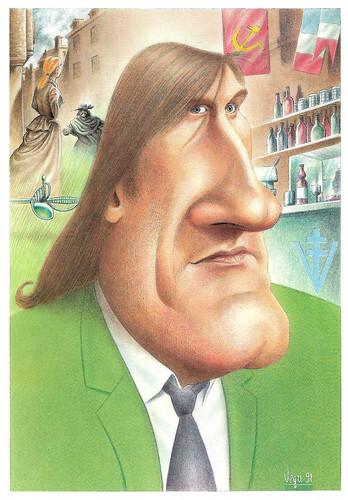
French postcard in the series 'De l'autre côté du miroir' by A.S.C.P.D., no. 1. Illustration: B. Veyri, 1991.
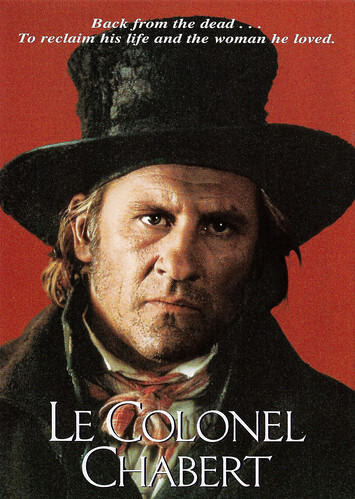
British postcard by Time Out. Photo: Guild. Gérard Depardieu in Le Colonel Chabert (Yves Angelo, 1994). Caption: Back from the dead... To reclaim his life and the woman he loved.
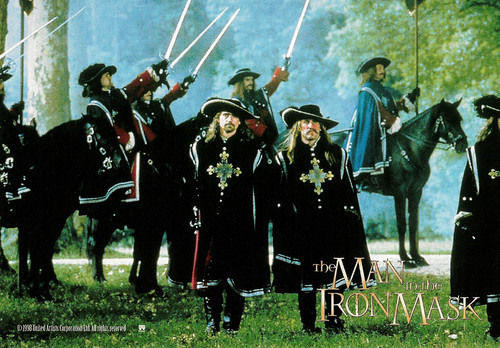
French postcard by Sonis, no. C. 853. Photo: United Artists. Gérard Depardieu and Jeremy Irons in The Man in the Iron Mask (Randall Wallace, 1998).
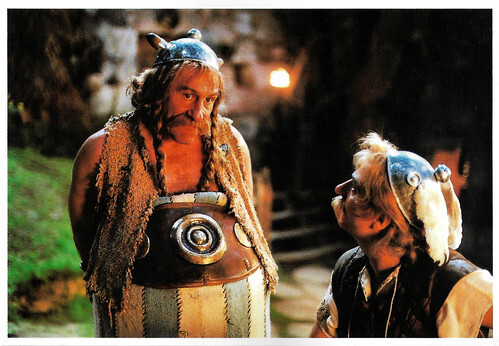
Small French postcard by AGFA / McCann Communications, Nanterre / Renn Productions. Photo: Etienne George. Christian Clavier and Gérard Depardieu in Astérix & Obélix contre César/Asterix and Obelix Take on Caesar (Claude Zidi, 1999).

Belgian Freecard by Boomerang. Photo: Mandarin Cinema.Gérard Depardieu in Potiche/Trophy Wife (François Ozon, 2010). Caption: Mother's child.
Trailer Maitresse (1978). Source: BFI Trailers (YouTube).
Sources: Ginette Vincendeau (Encyclopedia of European Cinema), Tracie Cooper (AllMovie), (IMDb), Wikipedia and .

French postcard in the Signes du Zodiaque by Editions F. Nugeron, no. 16. Caption: Capricorn.

French postcard by Editions La Malibran, Nancy, in the collection Cinéma Couleur, no. MC 16. Photo: Georges Pierre. Gérard Depardieu in Danton (Andrzej Wajda, 1983).

British postcard by Artificial Eye. Gérard Depardieu in Cyrano de Bergerac (Jean-Paul Rappeneau, 1990).

French postcard by Sonis, no. C. 854. Photo: United Artists. Gabriel Byrne, Leonardo DiCaprio , John Malkovich, Gérard Depardieu and Jeremy Irons in The Man in the Iron Mask (Randall Wallace, 1998).

Big Happy New Year card by Pathé. Photo: Christian Clavier and Gérard Depardieu in Astérix & Obélix contre César/Asterix and Obelix Take on Caesar (Claude Zidi, 1999).

Vintage autograph card.
Whimsical, aimless thug
Gérard Xavier Marcel Depardieu was born in working-class Châteauroux, France in 1948. He is one of five children of Anne Depardieu-Marillier called ‘la Liette’ and René ‘le Dédé’ Depardieu, a metal worker and volunteer fireman. As a boy, Depardieu spent more time on the street than in the classroom. According to Tracie Cooper at AllMovie : “At twelve years old, he dropped out of school and hitchhiked across Europe on an informal tour funded primarily by the profits of stolen cars and assorted black-market products. Depardieu would likely have continued in his juvenile delinquency were it not for a friend who was attending drama school in Paris.”
So in 1966, Depardieu decided to enrol at the École d'art dramatique too. He began acting in the new comedy theatre Café de la Gare, where he met actors Patrick Dewaere , Coluche , and Miou-Miou . He made his film debut in the short Le beatnik et le minet/The beatnik and pussy (Roger Leenhardt, 1967). More minor film parts followed. In 1970, he married Élisabeth Guignot, with whom he had two children, actor Guillaume (1971–2008) and actress Julie (1973).
In 1972, he appeared in Nathalie Granger (Marguerite Duras, 1972) with Lucia Bosé . The following year he played in the Horror film Au rendez-vous de la mort joyeuse/At the Meeting with Joyous Death (1973), directed by Juan Luis Buñuel, the son of Luis Buñuel. His breakout film was Bertrand Blier's comedy Les valseuses/Going Places (1974), in which he co-starred with Patrick Dewaere and Miou-Miou . Les valseuses was the 3rd highest grossing film of the year in France, and his part as a whimsical, aimless thug turned him into France’s young male sensation.
In the following years, he went on to become one of France's most renowned actors with films like Vincent, François, Paul... et les autres/Vincent, François, Paul and the Others (Claude Sautet, 1974) with Yves Montand , Sept morts sur ordonnance/Seven Deaths by Prescription (Jacques Rouffio, 1975) starring Michel Piccoli , and Maîtresse/mistress (Barbet Schroeder, 1976) starring Bulle Ogier. The latter provoked controversy in the United Kingdom and the United States because of its graphic depictions of sado-masochism. Then he was the co-star of Robert de Niro in the Italian epic film Novecento/1900 (Bernardo Bertolucci, 1976). The film chronicles the lives of two men during the political turmoil that took place in Italy in the first half of the 20th century. Also remarkable was La Dernière femme/The Last Woman (Marco Ferreri, 1976) starring Ornella Muti , in which his character mutilates himself.
Another success was the gritty romantic comedy Préparez vos mouchoirs/Get Out Your Handkerchiefs (Bertrand Blier, 1978), which received the Academy Award for Best Foreign Language Film. Other memorable films were Mon oncle d'Amérique/My American Uncle (Alain Resnais, 1980), which won the Grand Prix and the FIPRESCI prizes at the 1980 Cannes Film Festival, the drama Loulou (Maurice Pialat, 1980) with Isabelle Huppert , and Le Dernier Métro/The Last Metro (François Truffaut, 1980) starring Catherine Deneuve . The latter film, set in a small Parisian theatre during the time of the French received Oscar and Golden Globe nominations for Best Foreign Film and won ten Césars. Depardieu himself was awarded for his performance as a resistance fighter. Le Dernier Métro was one of the most popular films of the year in France and one of Truffaut's most successful productions abroad.

French postcard by RCA. Photo: GAMMA. Promotion card for his album 'Ils ont dit moteur...' (1980).

French postcard by La Roue Tourne, Paris.

French postcard by Humour a la Carte, Paris, no. 3442. Photo: Ilana Ben-Ari.

Swiss postcard by News Productions, Baulmes, no. 55506. Photo: Pierre-Olivier Deschamps / Agence VU, Paris, 1986.

French card with blank back.

French autograph card with blank back.
Exceptional talent, energy and versatility
During the 1980s Gérard Depardieu’s star continued to rise. Among his most memorable films are Truffaut's final film La femme d'à côté/The Woman Next Door (François Truffaut, 1981), the farce La chèvre/The Goat (Francis Veber, 1981) with Pierre Richard , the medieval drama Le retour de Martin Guerre/The Return of Martin Guerre (1982), and the historical biopic Danton (Andrzej Wajda, 1983).
Ginette Vincendeau writes in Encyclopedia of European Cinema : “Apart from exceptional talent and energy, a key to Depardieu’s success is his versatility. Equally at ease in broad farce and romantic leads, he has been a mainstay of popular cinema.” His international fame grew as a result of his performance as a doomed, hunchbacked farmer in Jean de Florette (Claude Berri, 1986) and Manon des sources (Claude Berri, 1986).
Five years later, he won a César and an Oscar nomination for his starring role in Cyrano de Bergerac (Jean-Paul Rappeneau, 1990). He did not win the Oscar, presumably because Time magazine had run a profile that mistakenly suggested that Depardieu might have ‘participated’ in a rape at the age of nine. The claim was based on an interview carried out 13 years earlier and was the result of an incorrect translation. However, Depardieu crossed over into the American film market by co-starring in Green Card (Peter Weir, 1990).
Ginette Vincendeau: “Like Jean Gabin before him, Depardieu sums up an idealised French masculinity, merging working-class virility with romanticism. Exporting himself has meant losing some of these complexities, since Depardieu’s global stardom is, so far, dependent (as was Maurice Chevalier ’s) on playing a rather clichéd Frenchness as in Green Card, or even Europeanness, as in Ridley Scott’s 1492 Conquest of Paradise (1992).”
In 1992, while separated from Élisabeth Guignot, he had a daughter, Roxanne, with the model Karine Sylla. In 1996 he divorced Élisabeth and began a relationship with actress Carole Bouquet, who was his partner from 1997 to 2005. Remarkable films from this period include Tous les matins du monde/All the mornings of the world (Alain Corneau, 1991), Una pura formalità/A Pure Formality (Giuseppe Tornatore, 1994), and Hamlet (Kenneth Branagh, 1996).

French card. Photo: Isabelle Huppert and Gérard Depardieu in Loulou (Maurice Pialat, 1980).

French postcard by Editions La Malibran, Nancy, in the collection Cinéma Couleur, no. MC 39. Publicity still for Loulou (Maurice Pialat, 1979) with Isabelle Huppert.

French postcard by F.E.C.V. Photo: Investimage. Gérard Depardieu in Sous le soleil de Satan (Maurice Pialat, 1987).

French postcard by Editions Ramsay / F. Nugeron, no. 40. Photo: Gaumont. Gérard Depardieu in Sous le soleil de Satan (Maurice Pialat, 1987). Caption: Palme d'or Cannes 1987.

French postcard. Photo: Artificial Eye. Anne Brochet, Vincent Perez and Gérard Depardieu in Cyrano de Bergerac (Jean-Paul Rappeneau, 1990).

French postcard by Sonis, no. C. 90. French poster for Cyrano de Bergerac (Jean-Paul Rappeneau, 1990) with Gérard Depardieu. Photo: Benoit Berbier. Concept: Serge Fichard, Bruno le Moult.
Obélix
In 1999, Gérard Depardieu played for the first time Obélix in the live-action film Astérix et Obélix contre César/Asterix and Obelix vs. Caesar (Claude Zidi, 1999) with Christian Clavier as Asterix. The film, based on the comic book by René Goscinny, was tremendously successful at the European box offices. There would be three sequels: Astérix & Obélix: Mission Cléopâtre/Asterix & Obelix: Mission Cleopatra (Alain Chabat, 2002), Astérix aux jeux olympiques/Asterix at the Olympic Games (Frédéric Forestier, Thomas Langmann, 2008) and Astérix et Obélix: Au service de Sa Majesté/Astérix and Obélix: God Save Britannia (Laurent Tirard, 2012).
In between he appeared in films as the comedy Le placard/The Closet (Francis Veber, 2001) with Daniel Auteuil, Tais-toi!/Shut Up (Francis Veber, 2003) with Jean Reno , the crime drama 36 Quai des Orfèvres/36 (Olivier Marchal, 2004), the Edith Piaf biopic La môme/La vie en rose (Olivier Dahan, 2007) featuring Marion Cotillard, the crime film L'instinct de mort/Mesrine: Part 1 - Killer Instinct (Jean-François Richet, 2008) and the follow-up L'ennemi public n°1/Mesrine: Part II - Public Enemy #1 (Jean-François Richet, 2008) both starring Vincent Cassel, and the drama À l'origine/In the Beginning (Xavier Giannoli, 2009).
Depardieu attracted attention from the media and legal authorities for his sometimes stormy behaviour. He made a concerted effort to cut back on his alcohol consumption following a heart attack and an emergency quintuple bypass operation, in 2000. In 2003, he officially cut off contact with his son, Guillaume Depardieu when the young man threatened him with a gun and received a suspended prison sentence. Since 2005, he has lived with novelist Clémentine Igou, but in 2006, he had a son, Jean, with Hélène Bizot. Meanwhile Guillaume made headlines for drug abuse, a motorbike crash and a hospital infection contracted during the post-accident operations, eventually leading to the amputation of his leg. At 37, Guillaume died from complications linked to a sudden case of pneumonia.
In August 2012, Depardieu was accused of assault and battery for punching a motorist in Paris. In November 2012, he was arrested for driving while intoxicated after he fell from his scooter. He has been an official resident of Néchin, Belgium since December 2012. French prime minister Jean-Marc Ayrault claimed the reason for the move was to avoid a looming 75% top rate of tax. Depardieu reacted with a public statement he was handing back his French passport. In January 2013, Russian President Vladimir Putin signed an Executive Order granting Russian citizenship to Depardieu. Depardieu soon returned the favour by attacking Putin's critics.
More importantly, he continues to make good films. In La tête en friche/My Afternoons with Margueritte (Jean Becker, 2010) he played an illiterate and lonely man who bonds with an older and well-read woman (Gisèle Casadesus). The comedy Potiche/Trophy Wife (François Ozon, 2010) reunited him with Catherine Deneuve . And he appeared in Life of Pi (Ang Lee, 2012), the TV series Marseille (2016-2018) and Illusions perdues/Lost Illusions (Xavier Giannoli, 2021), based on the classic novel by Honoré de Balzac. During his career, Gérard Depardieu has been nominated 15 times for the César for Best Actor and won it twice, in 1981 and 1991. He was also nominated for an Oscar in 1990 for his role in Cyrano de Bergerac. He is a Chevalier of the Légion d'honneur, Chevalier of the Ordre national du Mérite.

French postcard in the series 'De l'autre côté du miroir' by A.S.C.P.D., no. 1. Illustration: B. Veyri, 1991.

British postcard by Time Out. Photo: Guild. Gérard Depardieu in Le Colonel Chabert (Yves Angelo, 1994). Caption: Back from the dead... To reclaim his life and the woman he loved.

French postcard by Sonis, no. C. 853. Photo: United Artists. Gérard Depardieu and Jeremy Irons in The Man in the Iron Mask (Randall Wallace, 1998).

Small French postcard by AGFA / McCann Communications, Nanterre / Renn Productions. Photo: Etienne George. Christian Clavier and Gérard Depardieu in Astérix & Obélix contre César/Asterix and Obelix Take on Caesar (Claude Zidi, 1999).

Belgian Freecard by Boomerang. Photo: Mandarin Cinema.Gérard Depardieu in Potiche/Trophy Wife (François Ozon, 2010). Caption: Mother's child.
Trailer Maitresse (1978). Source: BFI Trailers (YouTube).
Sources: Ginette Vincendeau (Encyclopedia of European Cinema), Tracie Cooper (AllMovie), (IMDb), Wikipedia and .
Published on August 19, 2023 22:00
August 18, 2023
Gérard Philipe in East Germany
In 1956, the French idol Gérard Philipe worked in socialist East Germany. He starred as the popular jester in Les Aventures de Till L’Espiègle/Die Abenteuer des Till Ulenspiegel/The Adventures of Till Ulenspiegel (Gérard Philipe, Joris Ivens, 1956), a co-production between Ariane Film in France and DEFA in the GDR. The novel 'The Legend of Thyl Ulenspiegel and Lamme Goedzak' (1867) by Belgian author Charles De Coster served as the literary model. Coster's novel recounts the allegorical adventures as those of a Flemish prankster, Thyl Ulenspiegel, directly before and during the Dutch Revolt against Spanish rule in the Netherlands. It was the only time in his career that Gérard Philipe also directed a film. But when the Soviet tanks invaded Hungary, it lead to a great wave of indignation in France against the Eastern Bloc.
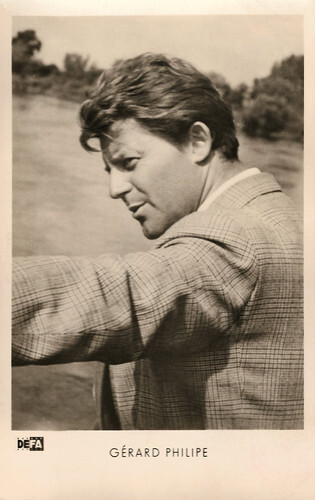
East German postcard by VEB DEFA-Studio für Spielfilme, Postdam-Babelsberg, no. 49, 1956. Photo: Pattenheimer.
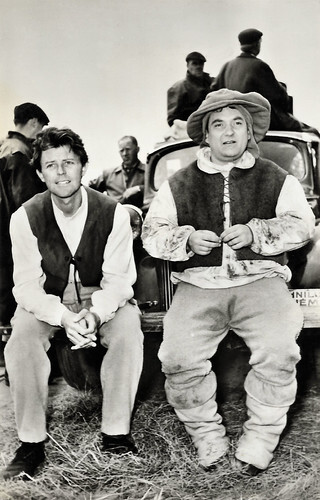
East German postcard by VEB Progress Film-Vertrieb, Berlin, no. 159, 1956. Photo: Gerhard Puhlmann. Gérard Philipe and Jean Carmet on the set of Les aventures de Till L'Espiègle/Bold Adventure (Gérard Philipe, Joris Ivens, 1956).
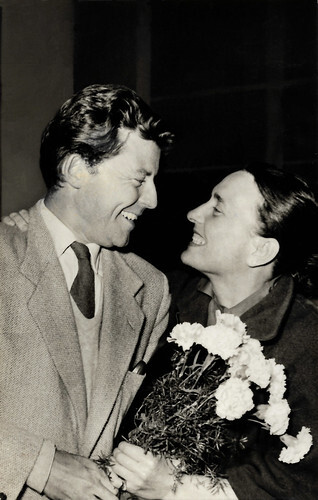
East German postcard by VEB Progress Film-Vertrieb, Berlin, no. 115, 1956. Photo: Gerhard Puhlmann. Gérard Philipe and German actress Elfriede Florin, who played Soetkin in Les Aventures de Till L’Espiègle/Die Abenteuer des Till Ulenspiegel/The Adventures of Till Ulenspiegel (Gérard Philipe, Joris Ivens, 1956).
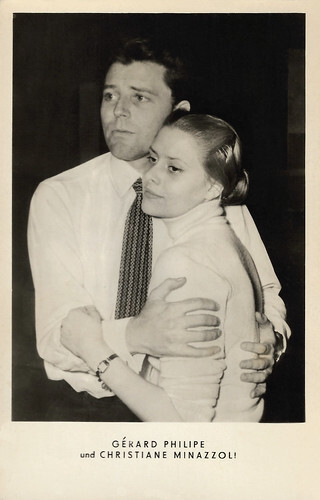
East German postcard by VEB Volkskunstverlag Reichenbach L.V., no. G 591, 1956. Photo: Zentralbild, Berlin. Gérard Philipe and Christiane Minazzoli, with whom he appeared in the play 'Ruys Blas' by Victor Hugo, directed by Jean Vilar at the Theatre National Populaire in Paris in 1954.
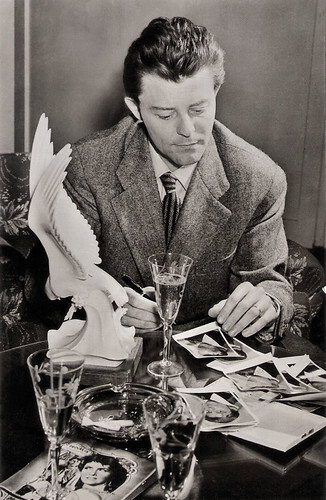
East German postcard by VEB Progress Film-Vertrieb, Berlin, no. 146, 1956. Photo: Gerhard Kiesling. Caption: Gérard Philipe gives autographs during his visit to Berlin.
A cheerful farce with a socially critical impetus
Flanders in the 16th century. In Les Aventures de Till L’Espiègle/Die Abenteuer des Till Ulenspiegel/The Adventures of Till Ulenspiegel (Gérard Philipe, Joris Ivens, 1956), the Duke of Alva (Jean Vilar) oppresses the Flemish people in the name of the Spanish king. At the very moment when Till Ulenspiegel ( Gérard Philipe ) and his beloved Nele ( Nicole Berger ) become engaged, the marauding band of troops reach the Flemish village of Damme. The rebel Claes ( Fernand Ledoux ), Tijl Uilenspiegel's father, is considered a heretic by the Spanish army. Tijl has to watch helplessly as his father is executed. "Long live freedom!" are Claes' last words before he dies at the stake. This experience, however, radically changes Till’s life: the young man, who was once the village lark and mischievous prankster, now becomes a fighter against the Spaniards and their governor, Alba. Together with his friend Lamme Goedzak (Jean Carmet), Tijl uses a ruse to enter the service of the Duke of Alva. That way he can better organise resistance against the Spanish. Prince William of Orange (Wilhelm Koch-Hooge) and the Beggars will assist him in this.
Gérard Philipe's real-life father, Marcel Philip, collaborated with the German occupiers during the Second World War. He was the administrator of the Parc Palace, the meeting place of the Germans in Grasse, and also a regional delegate and member of the "Comité directeur" of the Parti populaire français, a party founded by Jacques Doriot for the Alpes-Maritimes département. His son, Gérard, was his whole life a staunch social liberal and fought in the Résistance in August 1944, during the uprising for the liberation of Paris. Marcel Philip was imprisoned, first in Saint-Denis, then in Grasse. His son tried to use his connections to help him but was only partially successful. However, his father managed to escape in 1945 while his son was performing as Caligula in Paris. Marcel went to Spain and was sentenced to death in absentia. After an amnesty, he returned to France, ten years after his son's death.
Gérard Philipe came up with the idea of filming Charles De Coster's novel 'The Legend of Thyl Ulenspiegel and Lamme Goedzak' as early as 1949. However, it took him seven years to find producers who would support his project, as the book about Flanders' fight for freedom against the Spanish occupiers was considered too political and also criticised the Catholic Church with its Inquisition. The East German film company DEFA had been working on an adaptation of the material since the end of 1947, and Bertolt Brecht and Günther Weisenborn, among others, had been discussed as screenwriters. In addition, DEFA had been trying to have international artists appear in feature films since the beginning of the 1950s. Between 1956 and 1959, four co-productions were thus made between the GDR and France. Defa hoped to break the boycott to which its films were subjected in the East-West conflict: "The presence of world-famous actors such as Gérard Philipe [...] strengthens DEFA's self-confidence and promotes the international reputation of GDR cinematography."
Les Aventures de Till L’Espiègle/Die Abenteuer des Till Ulenspiegel/The Adventures of Till Ulenspiegel was shot in 1956 in non-socialist countries, i.e. countries with high exchange rates, in Sweden, the Netherlands and Nice, France. In Raguhn in Saxony-Anhalt, the battle between the Spanish and the Flemings was filmed with over a thousand extras in period costumes. The local cultural centre in Raguhn still bears the name 'Gérard Philipe'. Originally, the Dutch documentary filmmaker Joris Ivens was supposed to direct the film, and it was through his contacts that the co-production with DEFA ultimately came about. However, for scheduling reasons he had to cancel at the beginning of the shoot, so Gérard Philipe directed a film himself for the only time in his career. Ivens was sometimes at his side as an advisor. The film buildings were created by Léon Barsacq and Alfred Tolle. The costumes were designed by Rosine Delamare and Ingeborg Wilfert.
The film premiere of The Adventures of Till Ulenspiegel took place in Paris on 7 November 1956, shortly after the Hungarian People's Uprising against the ruling Communist Party had been crushed by the Soviet Army, leading to a great wave of indignation in France against the Eastern Bloc. French audiences reacted accordingly by flunking the film as a co-production with an East German film company. However, there were 2,304,114 admissions in France and thus the film was not a 'total commercial failure' as some sources suggest. The first screening in the GDR took place on 4 January 1957 at the Babylon cinema in Berlin. Pitt Herrmann at Filmportal.de: "GDR audiences took the national pathos of the title character, which was diametrically opposed to the internationalist aspirations of GDR socialism, as a reference to the 1956 Hungarian uprising, which was bloodily put down by Soviet troops. Of course, this was not the intention of the film people in Paris or Babelsberg." The many GDR postcards of Philipe give an indication how popular he was in the East Germany. The Encyclopedia of International Film described The Adventures of Till Ulenspiegel as a "large-scale production that suffers from directorial weaknesses". "Beautiful to look at, but rather tough" was the verdict of Cinema. Ralf Schenk wrote in the Berliner Zeitung that the film ultimately turned into "a turbulent, but also stylistically unbalanced, eclectic puzzle". As a "cheerful farce with a socially critical impetus", however, it could "still find its friends today", thanks above all to "the brilliant cast in supporting roles".
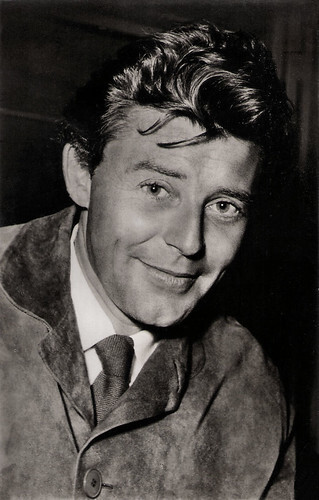
East German postcard by VEB Progress Film-Vertrieb, Berlin, no. 148, 1956. Photo: Gerhard Puhlmann.
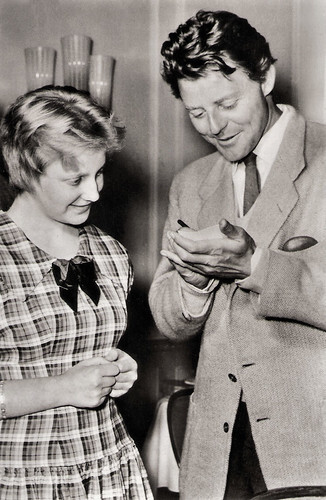
East-German postcard by VEB Progress Film-Vertrieb, Berlin, no. 158, 1956. Photo: Gerhard Puhlmann. Caption: Gérard Philipe is always pursued by autograph hunters.
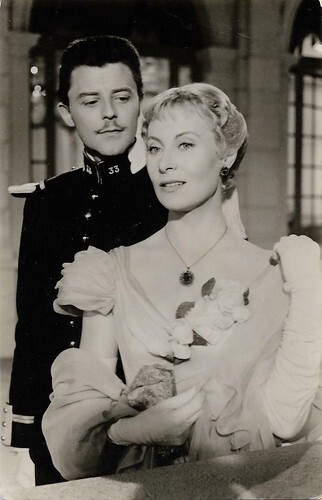
East-German postcard by VEB Progress Film-Vertrieb, Berlin, no. 194. Michèle Morgan and Gérard Philipe in Les grandes manoeuvres/Summer Manoeuvres (René Clair, 1955).
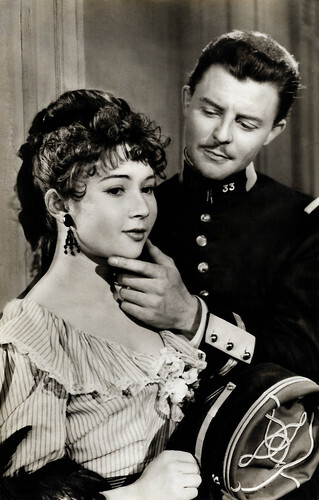
East-German postcard by VEB Progress Film-Vertrieb, Berlin, no. 212. Dany Carrel and Gérard Philipe in Les grandes manoeuvres/Summer Manoeuvres (René Clair, 1955).
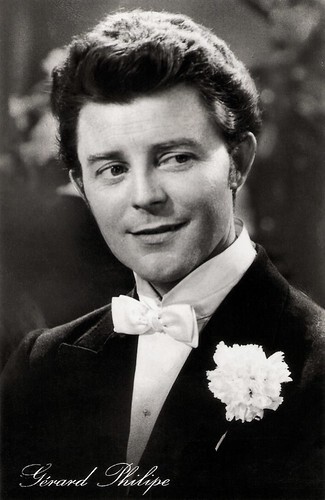
East-German postcard by VEB Progress Filmvertrieb, no. 1290, 1960. Photo: Gérard Philipe in Pot-Bouille/Lovers of Paris (Julien Duvivier, 1957).
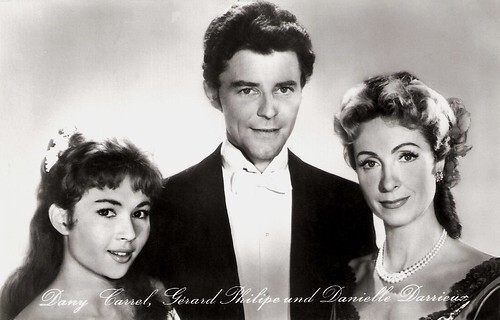
East-German postcard by VEB Progress Filmvertrieb, no. 1294, 1960. Photo: Dany Carrel , Gérard Philipe and Danièle Darrieux in Pot-Bouille/Lovers of Paris (Julien Duvivier, 1957), adapted from the novel by Emile Zola.
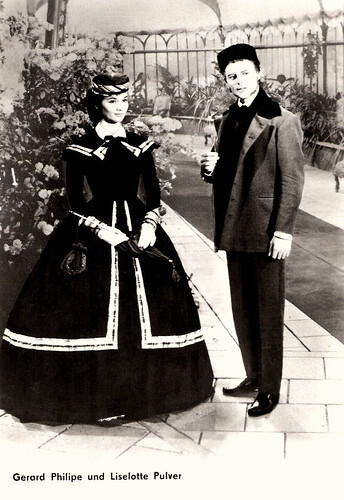
East-German postcard by VEB Progress Film-Vertrieb, no. 2699. Retail price: 0,20 MDN. Photo: Gérard Philipe and Liselotte Pulver in Le joueur/The Gambler (Claude Autant-Lara, 1958).
Sources: Pitt Herrmann (Filmportal.de), Renaud Soyer (Box Office Story), Stiftung DEFA Filme, Wikipedia (French, German and English) and IMDb.

East German postcard by VEB DEFA-Studio für Spielfilme, Postdam-Babelsberg, no. 49, 1956. Photo: Pattenheimer.

East German postcard by VEB Progress Film-Vertrieb, Berlin, no. 159, 1956. Photo: Gerhard Puhlmann. Gérard Philipe and Jean Carmet on the set of Les aventures de Till L'Espiègle/Bold Adventure (Gérard Philipe, Joris Ivens, 1956).

East German postcard by VEB Progress Film-Vertrieb, Berlin, no. 115, 1956. Photo: Gerhard Puhlmann. Gérard Philipe and German actress Elfriede Florin, who played Soetkin in Les Aventures de Till L’Espiègle/Die Abenteuer des Till Ulenspiegel/The Adventures of Till Ulenspiegel (Gérard Philipe, Joris Ivens, 1956).

East German postcard by VEB Volkskunstverlag Reichenbach L.V., no. G 591, 1956. Photo: Zentralbild, Berlin. Gérard Philipe and Christiane Minazzoli, with whom he appeared in the play 'Ruys Blas' by Victor Hugo, directed by Jean Vilar at the Theatre National Populaire in Paris in 1954.

East German postcard by VEB Progress Film-Vertrieb, Berlin, no. 146, 1956. Photo: Gerhard Kiesling. Caption: Gérard Philipe gives autographs during his visit to Berlin.
A cheerful farce with a socially critical impetus
Flanders in the 16th century. In Les Aventures de Till L’Espiègle/Die Abenteuer des Till Ulenspiegel/The Adventures of Till Ulenspiegel (Gérard Philipe, Joris Ivens, 1956), the Duke of Alva (Jean Vilar) oppresses the Flemish people in the name of the Spanish king. At the very moment when Till Ulenspiegel ( Gérard Philipe ) and his beloved Nele ( Nicole Berger ) become engaged, the marauding band of troops reach the Flemish village of Damme. The rebel Claes ( Fernand Ledoux ), Tijl Uilenspiegel's father, is considered a heretic by the Spanish army. Tijl has to watch helplessly as his father is executed. "Long live freedom!" are Claes' last words before he dies at the stake. This experience, however, radically changes Till’s life: the young man, who was once the village lark and mischievous prankster, now becomes a fighter against the Spaniards and their governor, Alba. Together with his friend Lamme Goedzak (Jean Carmet), Tijl uses a ruse to enter the service of the Duke of Alva. That way he can better organise resistance against the Spanish. Prince William of Orange (Wilhelm Koch-Hooge) and the Beggars will assist him in this.
Gérard Philipe's real-life father, Marcel Philip, collaborated with the German occupiers during the Second World War. He was the administrator of the Parc Palace, the meeting place of the Germans in Grasse, and also a regional delegate and member of the "Comité directeur" of the Parti populaire français, a party founded by Jacques Doriot for the Alpes-Maritimes département. His son, Gérard, was his whole life a staunch social liberal and fought in the Résistance in August 1944, during the uprising for the liberation of Paris. Marcel Philip was imprisoned, first in Saint-Denis, then in Grasse. His son tried to use his connections to help him but was only partially successful. However, his father managed to escape in 1945 while his son was performing as Caligula in Paris. Marcel went to Spain and was sentenced to death in absentia. After an amnesty, he returned to France, ten years after his son's death.
Gérard Philipe came up with the idea of filming Charles De Coster's novel 'The Legend of Thyl Ulenspiegel and Lamme Goedzak' as early as 1949. However, it took him seven years to find producers who would support his project, as the book about Flanders' fight for freedom against the Spanish occupiers was considered too political and also criticised the Catholic Church with its Inquisition. The East German film company DEFA had been working on an adaptation of the material since the end of 1947, and Bertolt Brecht and Günther Weisenborn, among others, had been discussed as screenwriters. In addition, DEFA had been trying to have international artists appear in feature films since the beginning of the 1950s. Between 1956 and 1959, four co-productions were thus made between the GDR and France. Defa hoped to break the boycott to which its films were subjected in the East-West conflict: "The presence of world-famous actors such as Gérard Philipe [...] strengthens DEFA's self-confidence and promotes the international reputation of GDR cinematography."
Les Aventures de Till L’Espiègle/Die Abenteuer des Till Ulenspiegel/The Adventures of Till Ulenspiegel was shot in 1956 in non-socialist countries, i.e. countries with high exchange rates, in Sweden, the Netherlands and Nice, France. In Raguhn in Saxony-Anhalt, the battle between the Spanish and the Flemings was filmed with over a thousand extras in period costumes. The local cultural centre in Raguhn still bears the name 'Gérard Philipe'. Originally, the Dutch documentary filmmaker Joris Ivens was supposed to direct the film, and it was through his contacts that the co-production with DEFA ultimately came about. However, for scheduling reasons he had to cancel at the beginning of the shoot, so Gérard Philipe directed a film himself for the only time in his career. Ivens was sometimes at his side as an advisor. The film buildings were created by Léon Barsacq and Alfred Tolle. The costumes were designed by Rosine Delamare and Ingeborg Wilfert.
The film premiere of The Adventures of Till Ulenspiegel took place in Paris on 7 November 1956, shortly after the Hungarian People's Uprising against the ruling Communist Party had been crushed by the Soviet Army, leading to a great wave of indignation in France against the Eastern Bloc. French audiences reacted accordingly by flunking the film as a co-production with an East German film company. However, there were 2,304,114 admissions in France and thus the film was not a 'total commercial failure' as some sources suggest. The first screening in the GDR took place on 4 January 1957 at the Babylon cinema in Berlin. Pitt Herrmann at Filmportal.de: "GDR audiences took the national pathos of the title character, which was diametrically opposed to the internationalist aspirations of GDR socialism, as a reference to the 1956 Hungarian uprising, which was bloodily put down by Soviet troops. Of course, this was not the intention of the film people in Paris or Babelsberg." The many GDR postcards of Philipe give an indication how popular he was in the East Germany. The Encyclopedia of International Film described The Adventures of Till Ulenspiegel as a "large-scale production that suffers from directorial weaknesses". "Beautiful to look at, but rather tough" was the verdict of Cinema. Ralf Schenk wrote in the Berliner Zeitung that the film ultimately turned into "a turbulent, but also stylistically unbalanced, eclectic puzzle". As a "cheerful farce with a socially critical impetus", however, it could "still find its friends today", thanks above all to "the brilliant cast in supporting roles".

East German postcard by VEB Progress Film-Vertrieb, Berlin, no. 148, 1956. Photo: Gerhard Puhlmann.

East-German postcard by VEB Progress Film-Vertrieb, Berlin, no. 158, 1956. Photo: Gerhard Puhlmann. Caption: Gérard Philipe is always pursued by autograph hunters.

East-German postcard by VEB Progress Film-Vertrieb, Berlin, no. 194. Michèle Morgan and Gérard Philipe in Les grandes manoeuvres/Summer Manoeuvres (René Clair, 1955).

East-German postcard by VEB Progress Film-Vertrieb, Berlin, no. 212. Dany Carrel and Gérard Philipe in Les grandes manoeuvres/Summer Manoeuvres (René Clair, 1955).

East-German postcard by VEB Progress Filmvertrieb, no. 1290, 1960. Photo: Gérard Philipe in Pot-Bouille/Lovers of Paris (Julien Duvivier, 1957).

East-German postcard by VEB Progress Filmvertrieb, no. 1294, 1960. Photo: Dany Carrel , Gérard Philipe and Danièle Darrieux in Pot-Bouille/Lovers of Paris (Julien Duvivier, 1957), adapted from the novel by Emile Zola.

East-German postcard by VEB Progress Film-Vertrieb, no. 2699. Retail price: 0,20 MDN. Photo: Gérard Philipe and Liselotte Pulver in Le joueur/The Gambler (Claude Autant-Lara, 1958).
Sources: Pitt Herrmann (Filmportal.de), Renaud Soyer (Box Office Story), Stiftung DEFA Filme, Wikipedia (French, German and English) and IMDb.
Published on August 18, 2023 22:00
August 17, 2023
Una Merkel
Una Merkel (1903–1986) was an American stage, film, radio, and television actress. In 1930, she went to Hollywood and became a popular film actress. Two of her best-known performances are in the films 42nd Street (1933) and Destry Rides Again (1939). She won a Tony Award in 1956 and was nominated for an Oscar for her role in Summer and Smoke (1962).
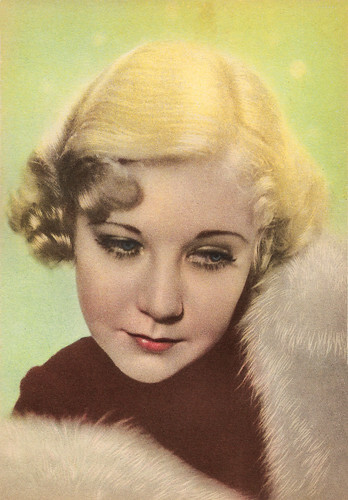
Italian postcard by NMM, Milano, 1941-XIX. Caption: Una Merkel - with a tender and mischievous look that harmonises, in appearance, panache, grace, and sweetness.
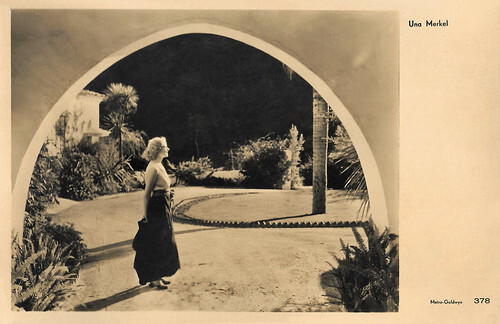
Dutch postcard by JosPe, Arnhem, no. 378. Photo: Metro-Goldwyn-Mayer (MGM).
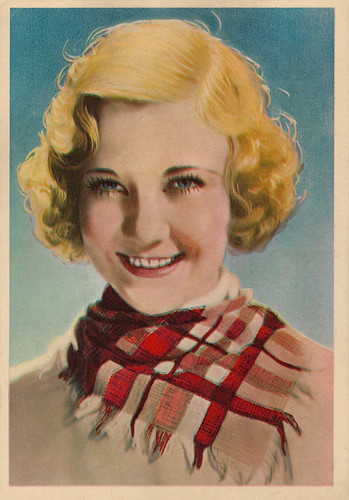
British postcard by De Reszke Cigarettes, no. 7. Photo: Metro-Goldwyn-Mayer (MGM).
A catfight with Marlene Dietrich
Una Merkel was born in 1903 in Covington, Kentucky, USA, as the daughter of a merchant, Arno Merkel and his wife Bess Merkel (née Phares). Una grew up in various locations in the southern states, due to her father's job as a travelling salesman. After settling in New York City, she attended the Alviene School of Dramatic Art.
Because of her strong resemblance to actress Lillian Gish , Merkel was offered a part as Gish's youngest sister in a silent film called World Shadows. However, the funding for the film dried up and it was never completed. According to AllMovie , she was Lillian Gish's stand-in for Way Down East (D.W. Griffith, 1920). Merkel went on to appear in a few silent movies for the Lee Bradford Corporation. She appeared in the two-reel Love's Old Sweet Song (J. Searle Dawley, 1923), which was made by Lee de Forest in his Phonofilm sound-on-film process and starred Louis Wolheim and Helen Weir. Not making much of a mark in films, Merkel turned her attention to the theatre.
She made her Broadway debut in February 1923 with 'Two by Two'. A triumph she had in 'Coquette' (1927), which starred her idol, Helen Hayes. In 1930, the success of 'Girl Crazy' confirmed her reputation. Merkel returned to Hollywood to star in the role of Ann Rutledge in David Wark Griffith 's biopic of the 16th President of the United States, Abraham Lincoln (D.W. Griffith, 1930) opposite Walter Huston. In addition, she played, among others, Sam Spade's secretary Effie in the first film version of The Maltese Falcon (Roy Del Ruth, 1931) starring Ricardo Cortez and Bebe Daniels .
After gaining a few pounds, her comic potential was discovered. In the following years, Merkel relied mainly on numerous, mostly comical supporting roles. Films to watch include Private Lives (Sidney Franklin, 1931) with Norma Shearer , Red-Headed Woman (Jack Conway, 1932) and Bombshell (Victor Fleming, 1933) starring Jean Harlow . Often she was the wisecracking best friend of the heroine such as in the Busby Berkeley musical film 42nd Street (Lloyd Bacon, 1933). With her broad Southern accent and her peroxide blond hair, she gave one of her best performances as the wisecracking but not-so-bright chorus girl Lorraine, a buddy of Ginger Rogers . She memorably says of Rogers' character Anytime Annie: "The only time she ever said no she didn't hear the question."
Other memorable roles were in The Merry Widow (Ernst Lubitsch, 1934), Broadway Melody of 1936 (Roy Del Ruth, W.S. Van Dyke, 1935) and Born to Dance (Roy Del Ruth, 1936). One of the most famous appearances she had was in the Western comedy Destry Rides Again (George Marshall, 1939), in which she delivers a hair-pulling 'catfight' with Marlene Dietrich . She was also wonderful as the eldest daughter of W. C. Fields in the comedy The Bank Detective (Edward F. Cline, 1940).
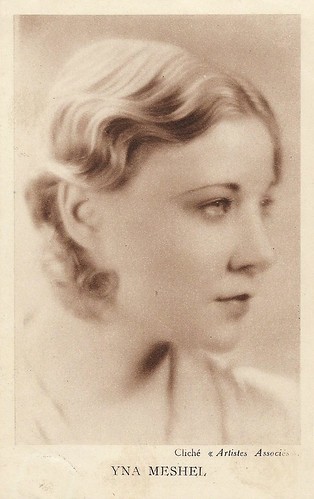
Belgian postcard. by S.A. Cacao et Chocolat Kivou, Vilvo[o]rde, Belgium. Her name is seriously misspelt on the card.
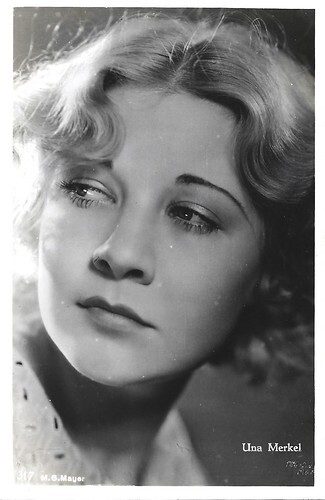
Dutch postcard by JosPe, Arnhem, no. 317. Photo: Metro-Goldwyn-Mayer.
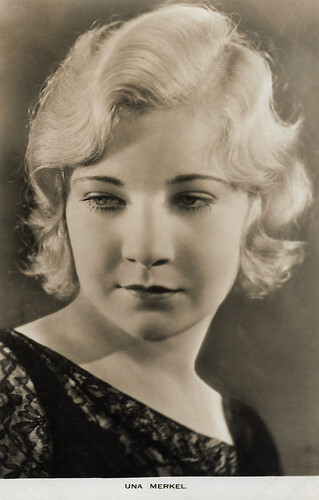
British postcard in the Film Weekly Series, London.
Surprise success
In the 1940s, Una Merkel had to settle for roles in mostly second-rate films. She almost died on 5 March 1945 when her mother Bessie, with whom she shared an apartment in New York City, committed suicide by turning on the gas. Merkel was overcome by the five gas jets her mother had turned on in their kitchen and was found unconscious in her bedroom. Her mother's suicide note was personalised to Una's husband, Robert Burla, whom she affectionately addressed as "Bid". Burla and Merkel had separated in April 1944. Merkel filed for divorce in 1946 and it was granted in 1947.
.
The surprise success of the baseball comedy Kill the Umpire (Lloyd Bacon, 1950) on the side of William Bendix gave her again roles in major films such as With a Song in My Heart (Walter Lang, 1952), where she played mostly mothers or housekeepers. On 4 March 1952, seven years almost to the day after her mother died, Merkel overdosed on sleeping pills. She was found unconscious by a nurse who was caring for her at the time and remained in a coma for a day before recovering.
Merkel returned to the stage and especially 'The Ponder Heart' by Eudora Welty was again a success. Merkel was awarded the Tony Award for her role. She had a major part in the film The Mating Game (George T. Marshall, 1959) as Paul Douglas's wife and Debbie Reynolds' mother. In 1962 she received an Oscar nomination as best supporting actress for her role in Summer and Smoke (Peter Glenville, 1961), starring Laurence Harvey and Geraldine Page and based on the Tennessee Williams play of the same name. Merkel had originated her role on the stage.
She was also featured as Brian Keith's housekeeper, Verbena, in the Walt Disney comedy The Parent Trap (David Swift, 1961), based on the 1949 book 'Lisa and Lottie' (German: 'Das doppelte Lottchen') by Erich Kästner. It stars Hayley Mills in a dual role as a pair of teenage twins plotting to reunite their divorced parents by switching places with each other. Her last film was the musical comedy Spinout (Norman Taurog, 1966) with Elvis Presley . Then Una Merkel retired to private life.
From 1932 until the divorce in 1947 Merkel was married to North American Aviation executive Ronald L. Burla, and the couple had no children. Una Merkel passed away in 1986 in Los Angeles. She was interred near her parents, Arno and Bess Merkel, at Highland Cemetery in Fort Mitchell, Kentucky. For her filmmaking, Una Merkel was honoured with a star on the Hollywood Walk of Fame.
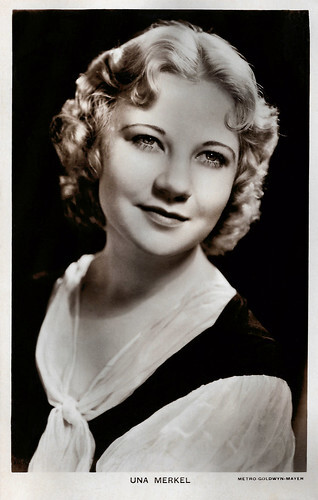
British postcard in the Picturegoer Series, London, no. 741. Photo: Metro-Goldwyn-Mayer.
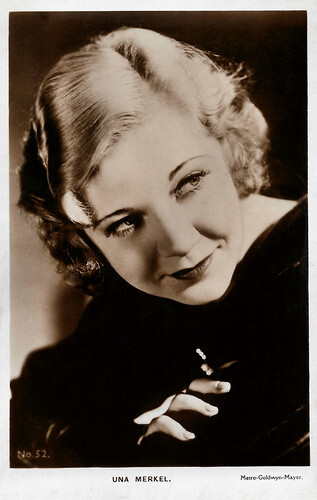
British postcard. British Film-Kurier series, London, no. 52. Metro-Goldwyn-Mayer.
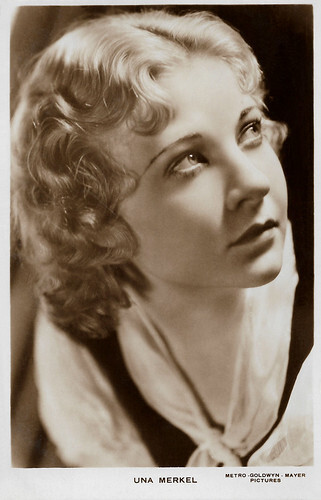
British postcard. Photo: Metro-Goldwyn-Mayer.
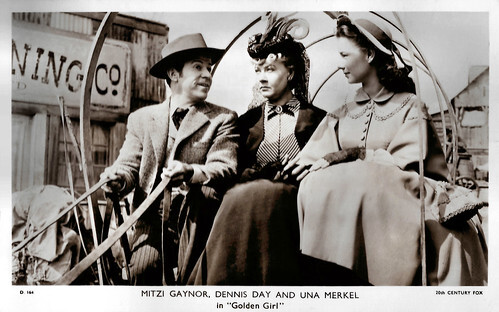
British postcard in the Picturegoer Series, London, no. D 164. Photo: Metro-Goldwyn-Mayer (MGM). Dennis Day, Una Merkel and Mitzi Gaynor in Golden Girl (Lloyd Bacon, 1951).
Sources: AllMovie, Wikipedia (English) and .

Italian postcard by NMM, Milano, 1941-XIX. Caption: Una Merkel - with a tender and mischievous look that harmonises, in appearance, panache, grace, and sweetness.

Dutch postcard by JosPe, Arnhem, no. 378. Photo: Metro-Goldwyn-Mayer (MGM).

British postcard by De Reszke Cigarettes, no. 7. Photo: Metro-Goldwyn-Mayer (MGM).
A catfight with Marlene Dietrich
Una Merkel was born in 1903 in Covington, Kentucky, USA, as the daughter of a merchant, Arno Merkel and his wife Bess Merkel (née Phares). Una grew up in various locations in the southern states, due to her father's job as a travelling salesman. After settling in New York City, she attended the Alviene School of Dramatic Art.
Because of her strong resemblance to actress Lillian Gish , Merkel was offered a part as Gish's youngest sister in a silent film called World Shadows. However, the funding for the film dried up and it was never completed. According to AllMovie , she was Lillian Gish's stand-in for Way Down East (D.W. Griffith, 1920). Merkel went on to appear in a few silent movies for the Lee Bradford Corporation. She appeared in the two-reel Love's Old Sweet Song (J. Searle Dawley, 1923), which was made by Lee de Forest in his Phonofilm sound-on-film process and starred Louis Wolheim and Helen Weir. Not making much of a mark in films, Merkel turned her attention to the theatre.
She made her Broadway debut in February 1923 with 'Two by Two'. A triumph she had in 'Coquette' (1927), which starred her idol, Helen Hayes. In 1930, the success of 'Girl Crazy' confirmed her reputation. Merkel returned to Hollywood to star in the role of Ann Rutledge in David Wark Griffith 's biopic of the 16th President of the United States, Abraham Lincoln (D.W. Griffith, 1930) opposite Walter Huston. In addition, she played, among others, Sam Spade's secretary Effie in the first film version of The Maltese Falcon (Roy Del Ruth, 1931) starring Ricardo Cortez and Bebe Daniels .
After gaining a few pounds, her comic potential was discovered. In the following years, Merkel relied mainly on numerous, mostly comical supporting roles. Films to watch include Private Lives (Sidney Franklin, 1931) with Norma Shearer , Red-Headed Woman (Jack Conway, 1932) and Bombshell (Victor Fleming, 1933) starring Jean Harlow . Often she was the wisecracking best friend of the heroine such as in the Busby Berkeley musical film 42nd Street (Lloyd Bacon, 1933). With her broad Southern accent and her peroxide blond hair, she gave one of her best performances as the wisecracking but not-so-bright chorus girl Lorraine, a buddy of Ginger Rogers . She memorably says of Rogers' character Anytime Annie: "The only time she ever said no she didn't hear the question."
Other memorable roles were in The Merry Widow (Ernst Lubitsch, 1934), Broadway Melody of 1936 (Roy Del Ruth, W.S. Van Dyke, 1935) and Born to Dance (Roy Del Ruth, 1936). One of the most famous appearances she had was in the Western comedy Destry Rides Again (George Marshall, 1939), in which she delivers a hair-pulling 'catfight' with Marlene Dietrich . She was also wonderful as the eldest daughter of W. C. Fields in the comedy The Bank Detective (Edward F. Cline, 1940).

Belgian postcard. by S.A. Cacao et Chocolat Kivou, Vilvo[o]rde, Belgium. Her name is seriously misspelt on the card.

Dutch postcard by JosPe, Arnhem, no. 317. Photo: Metro-Goldwyn-Mayer.

British postcard in the Film Weekly Series, London.
Surprise success
In the 1940s, Una Merkel had to settle for roles in mostly second-rate films. She almost died on 5 March 1945 when her mother Bessie, with whom she shared an apartment in New York City, committed suicide by turning on the gas. Merkel was overcome by the five gas jets her mother had turned on in their kitchen and was found unconscious in her bedroom. Her mother's suicide note was personalised to Una's husband, Robert Burla, whom she affectionately addressed as "Bid". Burla and Merkel had separated in April 1944. Merkel filed for divorce in 1946 and it was granted in 1947.
.
The surprise success of the baseball comedy Kill the Umpire (Lloyd Bacon, 1950) on the side of William Bendix gave her again roles in major films such as With a Song in My Heart (Walter Lang, 1952), where she played mostly mothers or housekeepers. On 4 March 1952, seven years almost to the day after her mother died, Merkel overdosed on sleeping pills. She was found unconscious by a nurse who was caring for her at the time and remained in a coma for a day before recovering.
Merkel returned to the stage and especially 'The Ponder Heart' by Eudora Welty was again a success. Merkel was awarded the Tony Award for her role. She had a major part in the film The Mating Game (George T. Marshall, 1959) as Paul Douglas's wife and Debbie Reynolds' mother. In 1962 she received an Oscar nomination as best supporting actress for her role in Summer and Smoke (Peter Glenville, 1961), starring Laurence Harvey and Geraldine Page and based on the Tennessee Williams play of the same name. Merkel had originated her role on the stage.
She was also featured as Brian Keith's housekeeper, Verbena, in the Walt Disney comedy The Parent Trap (David Swift, 1961), based on the 1949 book 'Lisa and Lottie' (German: 'Das doppelte Lottchen') by Erich Kästner. It stars Hayley Mills in a dual role as a pair of teenage twins plotting to reunite their divorced parents by switching places with each other. Her last film was the musical comedy Spinout (Norman Taurog, 1966) with Elvis Presley . Then Una Merkel retired to private life.
From 1932 until the divorce in 1947 Merkel was married to North American Aviation executive Ronald L. Burla, and the couple had no children. Una Merkel passed away in 1986 in Los Angeles. She was interred near her parents, Arno and Bess Merkel, at Highland Cemetery in Fort Mitchell, Kentucky. For her filmmaking, Una Merkel was honoured with a star on the Hollywood Walk of Fame.

British postcard in the Picturegoer Series, London, no. 741. Photo: Metro-Goldwyn-Mayer.

British postcard. British Film-Kurier series, London, no. 52. Metro-Goldwyn-Mayer.

British postcard. Photo: Metro-Goldwyn-Mayer.

British postcard in the Picturegoer Series, London, no. D 164. Photo: Metro-Goldwyn-Mayer (MGM). Dennis Day, Una Merkel and Mitzi Gaynor in Golden Girl (Lloyd Bacon, 1951).
Sources: AllMovie, Wikipedia (English) and .
Published on August 17, 2023 22:00
August 16, 2023
Revolutionshochzeit (1928)
EFSP's co-editor Ivo Blom is in Germany, where he visits the Bonn Stumfilmtage. Tonight he attends the screening of
Revolutionshochzeit/The Last Night
(1929), a revolutionary drama which shows the sophistication with which a "mere entertainment film" could be made in the late 1920s. The stage play, 'Revolutionsbryllup', on which the film is based, by the famous Danish writer Sophus Michaëlis, had previously been filmed four times in Denmark and Germany. This last silent film adaptation is a masterstroke of international cooperation: a Danish director, A.W. Sandberg, staged a Danish play with French content on behalf of a German production company. The small ensemble consisted of the Swede Gösta Eckman, the Italian Diomira Jacobini, the Austrian Fritz Kortner, the German Walter Rilla and the Dane Karina Bell. And the 35mm print that is shown in Bonn comes from the Danish Film Institute in Copenhagen.
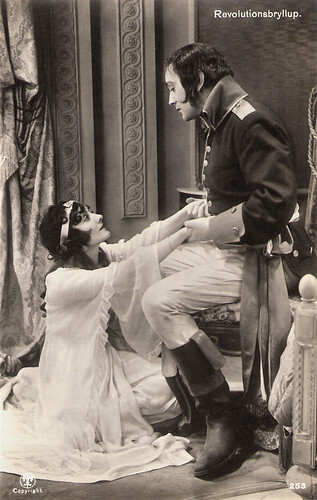
Danish postcard by Alex. Vincent's Kunstforlag, Eneret, no. 253. Photo: Diomira Jacobini and Gösta Ekman in Revolutionshochzeit/ The Last Night (A.W. Sandberg, 1927).

Danish postcard by Alex. Vincent's Kunstforlag, Eneret, no. 254. Photo: publicity still for Revolutionshochzeit/The Last Night (A.W. Sandberg, 1928). This was a German-Danish dramatisation of Sophus Michaëlis' play 'Revolutionsbryllup' (Revolutionary Wedding) and produced by Terra-Filmkunst. This card shows left Gösta Ekman and Karina Bell and in the back Fritz Kortner as the Jacobine Monteloup, and right Diomira Jacobini whose character, the aristocratic Alaine, has changed clothes with her maid Leontine ( Karina Bell ) to get a pass to leave Paris.
Paris in 1793, in the midst of the French Revolution
Revolutionshochzeit/Revolution Wedding (A.W. Sandberg, 1928) evolves in Paris in 1793, in the midst of the French Revolution. To fulfil her late father's last wish, the Comtesse Alaine de l'Estelle has become engaged to the noble Erneste de Tressailles.
Alaine de l’Estelle ( Diomira Jacobini ) and her maid Leontine ( Karina Bell ) try to flee Paris. Alaine is expected by her fiance, Ernest de Tresailles (Walter Rilla), at the castle of Trionville.
Erneste is fighting as a so-called émigré officer in the Austrian army against the Republicans. When Erneste is stationed near Alaine's castle of Trionville, he visits her in order to marry quickly. But that's when a Republican army led by the cold-hearted citizen-commissar Jacobine Monteloup ( Fritz Kortner ) invades the chateau and arrests Erneste.
As an émigré officer and enemy of the people, he is sentenced to death. In order to save Erneste, Alaine asks the good-natured Republican lieutenant Marc-Arron ( Gösta Ekman ) for help. He is a member of the Jacobines, who right after the marriage of Ernest and Alaine occupy Trionville.
For the love of Alaine, Marc tries to help Ernest and, consequently, is arrested and executed.
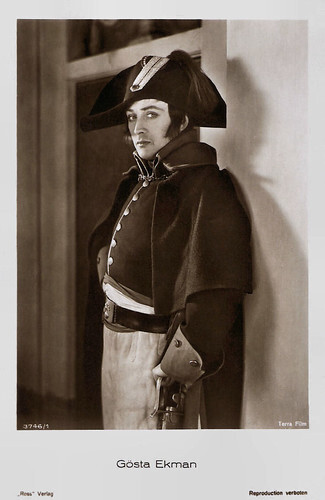
German postcard by Ross Verlag, no. 3746/1, 1928-1929. Photo: Terra Film. Gösta Ekman in the Revolutionshochzeit/Revolution Wedding (A.W. Sandberg, 1928).
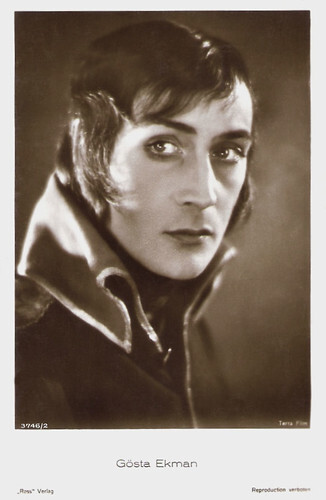
German postcard by Ross Verlag, no. 3746/2, 1928-1929. Photo: Terra Film. Gösta Ekman in the Revolutionshochzeit/Revolution Wedding (A.W. Sandberg, 1928).
A still enjoyable film full of excitement
Revolutionshochzeit/Revolution Wedding (A.W. Sandberg, 1928) is an adaptation by Norbert Falk and Robert Liebmann of the 1906 play of the same name by Sophus Michaelis and was produced by the Berlin company Terra-Film AG. Filming took place in the Terra Glass House and the surrounding area of Paris.
After passing through the Reich film censors, who gave the film the rating "Volksbildend" (educating the people), it premiered in Berlin (Mozartsaal) on 3 October 1928. In the following weeks, it was shown in other European countries, and later worldwide.
Revolutionshochzeit/Revolution Wedding was described by contemporary critics as a "top work", a "great film" and a "great revolutionary film". In particular, the courage of the tragic ending and the performance of Gösta Ekman and the direction of Anders Wilhelm Sandberg were praised.
Hans Wollenberg in Lichtbild-Bühne, no. 239, 4.10.1928: A. W. Sandberg, the Danish director, not only proves to be a master of the magnificent, splendidly moving and animated mass scenes but rather, above the outer unfolding, devotes all his love to the inner human core and thus to the actual play scenes with the finest feeling for the unravelling of the human heart, makes his directorial achievement an artistic deed. One must realise the unusual tasks that this demanding subject confronted the director with in order to appreciate the rich and great art of interpretation to which it owes its realisation as a silent film.
Revolutionshochzeit/Revolution Wedding was popular with the public, but after the film had been shown in cinemas, it fell into oblivion. It took till 2010 for a print from Moscow to emerge at the film archive of Toulouse, which was sent to the Filmmuseum Potsdam, where it was restored and re-premiered in March 2011. It was considered then to have an overdose of pathos and heroism, but it is also an enjoyable film full of excitement.
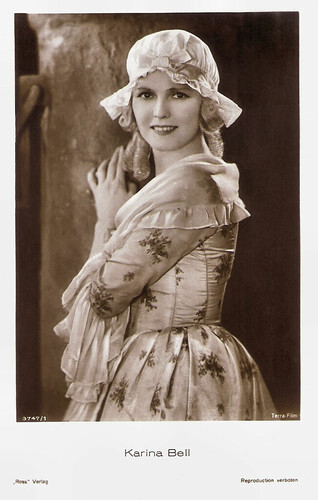
German postcard by Ross Verlag, no. 3747/1, 1928-1929. Photo: Terra Film. Karina Bell in Revolutionshochzeit/The Last Night (A.W. Sandberg, 1928).
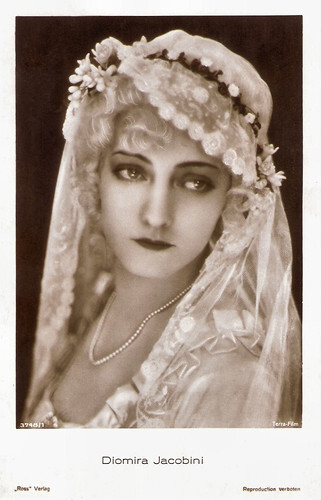
German postcard by Ross Verlag, no. 3748/1, 1928-1929. Source: Terra-Film. Diomira Jacobini in Revolutionshochzeit/The Last Night (A.W. Sandberg, 1928).
Sources: Bonn Stumfilmtage (German), Wikipedia (German) and IMDb.

Danish postcard by Alex. Vincent's Kunstforlag, Eneret, no. 253. Photo: Diomira Jacobini and Gösta Ekman in Revolutionshochzeit/ The Last Night (A.W. Sandberg, 1927).

Danish postcard by Alex. Vincent's Kunstforlag, Eneret, no. 254. Photo: publicity still for Revolutionshochzeit/The Last Night (A.W. Sandberg, 1928). This was a German-Danish dramatisation of Sophus Michaëlis' play 'Revolutionsbryllup' (Revolutionary Wedding) and produced by Terra-Filmkunst. This card shows left Gösta Ekman and Karina Bell and in the back Fritz Kortner as the Jacobine Monteloup, and right Diomira Jacobini whose character, the aristocratic Alaine, has changed clothes with her maid Leontine ( Karina Bell ) to get a pass to leave Paris.
Paris in 1793, in the midst of the French Revolution
Revolutionshochzeit/Revolution Wedding (A.W. Sandberg, 1928) evolves in Paris in 1793, in the midst of the French Revolution. To fulfil her late father's last wish, the Comtesse Alaine de l'Estelle has become engaged to the noble Erneste de Tressailles.
Alaine de l’Estelle ( Diomira Jacobini ) and her maid Leontine ( Karina Bell ) try to flee Paris. Alaine is expected by her fiance, Ernest de Tresailles (Walter Rilla), at the castle of Trionville.
Erneste is fighting as a so-called émigré officer in the Austrian army against the Republicans. When Erneste is stationed near Alaine's castle of Trionville, he visits her in order to marry quickly. But that's when a Republican army led by the cold-hearted citizen-commissar Jacobine Monteloup ( Fritz Kortner ) invades the chateau and arrests Erneste.
As an émigré officer and enemy of the people, he is sentenced to death. In order to save Erneste, Alaine asks the good-natured Republican lieutenant Marc-Arron ( Gösta Ekman ) for help. He is a member of the Jacobines, who right after the marriage of Ernest and Alaine occupy Trionville.
For the love of Alaine, Marc tries to help Ernest and, consequently, is arrested and executed.

German postcard by Ross Verlag, no. 3746/1, 1928-1929. Photo: Terra Film. Gösta Ekman in the Revolutionshochzeit/Revolution Wedding (A.W. Sandberg, 1928).

German postcard by Ross Verlag, no. 3746/2, 1928-1929. Photo: Terra Film. Gösta Ekman in the Revolutionshochzeit/Revolution Wedding (A.W. Sandberg, 1928).
A still enjoyable film full of excitement
Revolutionshochzeit/Revolution Wedding (A.W. Sandberg, 1928) is an adaptation by Norbert Falk and Robert Liebmann of the 1906 play of the same name by Sophus Michaelis and was produced by the Berlin company Terra-Film AG. Filming took place in the Terra Glass House and the surrounding area of Paris.
After passing through the Reich film censors, who gave the film the rating "Volksbildend" (educating the people), it premiered in Berlin (Mozartsaal) on 3 October 1928. In the following weeks, it was shown in other European countries, and later worldwide.
Revolutionshochzeit/Revolution Wedding was described by contemporary critics as a "top work", a "great film" and a "great revolutionary film". In particular, the courage of the tragic ending and the performance of Gösta Ekman and the direction of Anders Wilhelm Sandberg were praised.
Hans Wollenberg in Lichtbild-Bühne, no. 239, 4.10.1928: A. W. Sandberg, the Danish director, not only proves to be a master of the magnificent, splendidly moving and animated mass scenes but rather, above the outer unfolding, devotes all his love to the inner human core and thus to the actual play scenes with the finest feeling for the unravelling of the human heart, makes his directorial achievement an artistic deed. One must realise the unusual tasks that this demanding subject confronted the director with in order to appreciate the rich and great art of interpretation to which it owes its realisation as a silent film.
Revolutionshochzeit/Revolution Wedding was popular with the public, but after the film had been shown in cinemas, it fell into oblivion. It took till 2010 for a print from Moscow to emerge at the film archive of Toulouse, which was sent to the Filmmuseum Potsdam, where it was restored and re-premiered in March 2011. It was considered then to have an overdose of pathos and heroism, but it is also an enjoyable film full of excitement.

German postcard by Ross Verlag, no. 3747/1, 1928-1929. Photo: Terra Film. Karina Bell in Revolutionshochzeit/The Last Night (A.W. Sandberg, 1928).

German postcard by Ross Verlag, no. 3748/1, 1928-1929. Source: Terra-Film. Diomira Jacobini in Revolutionshochzeit/The Last Night (A.W. Sandberg, 1928).
Sources: Bonn Stumfilmtage (German), Wikipedia (German) and IMDb.
Published on August 16, 2023 22:00
Revolutionsbryllup (1928)
EFSP's co-editor Ivo Blom is in Germany, where he visits the Bonn Stumfilmtage. Tonight he attends the screening of Revolutionsbryllup/Die große Liebe/The Last Night (1929), a revolutionary drama which shows the sophistication with which a "mere entertainment film" could be made in the late 1920s. The stage play on which the film is based, by the popular Danish writer Sophus Michaëlis, had previously been filmed four times in Denmark and Germany. This last silent film adaptation is a masterstroke of international cooperation: a Danish director, A.W. Sandberg, staged a Danish play with French content on behalf of a German production company. The small ensemble consisted of the Swede Gösta Eckman, the Italian Diomira Jacobini, the Austrian Fritz Kortner, the German Walter Rilla and the Dane Karina Bell. And the 35mm print that is shown in Bonn comes from the Danish Film Institute in Copenhagen.

Danish postcard by Alex. Vincent's Kunstforlag, Eneret, no. 253. Photo: Diomira Jacobini and Gösta Ekman in Revolutionsbryllup/ Revolutionshochzeit/ The Last Night (A.W. Sandberg, 1927).

Danish postcard by Alex. Vincent's Kunstforlag, Eneret, no. 254. Photo: publicity still for Revolutionshochzeit/Revolutionsbryllup/The Last Night (A.W. Sandberg, 1928). This was a German-Danish dramatisation of Sophus Michaëlis' play 'Revolutionsbryllup' (Revolutionary Wedding) and produced by Terra-Filmkunst. This card shows left Gösta Ekman and Karina Bell and in the back Fritz Kortner as the Jacobine Monteloup, and right Diomira Jacobini whose character, the aristocratic Alaine, has changed clothes with her maid Leontine ( Karina Bell ) to get a pass to leave Paris.
Paris in 1793, in the midst of the French Revolution
Revolutionshochzeit/ Revolutionsbryllup/ Revolution Wedding (A.W. Sandberg, 1928) evolves in Paris in 1793, in the midst of the French Revolution. To fulfil her late father's last wish, the Comtesse Alaine de l'Estelle has become engaged to the noble Erneste de Tressailles.
Alaine de l’Estelle ( Diomira Jacobini ) and her maid Leontine ( Karina Bell ) try to flee Paris. Alaine is expected by her fiance, Ernest de Tresailles (Walter Rilla), at the castle of Trionville.
Erneste is fighting as a so-called émigré officer in the Austrian army against the Republicans. When Erneste is stationed near Alaine's castle of Trionville, he visits her in order to marry quickly. But that's when a Republican army led by the cold-hearted citizen-commissar Jacobine Monteloup ( Fritz Kortner ) invades the chateau and arrests Erneste.
As an émigré officer and enemy of the people, he is sentenced to death. In order to save Erneste, Alaine asks the good-natured Republican lieutenant Marc-Arron ( Gösta Ekman ) for help. He is a member of the Jacobines, who right after the marriage of Ernest and Alaine occupy Trionville.
For the love of Alaine, Marc tries to help Ernest and as a consequence is arrested and executed.

German postcard by Ross Verlag, no. 3746/1, 1928-1929. Photo: Terra Film. Gösta Ekman in the Revolutionshochzeit/Revolutionsbryllup/Revolution Wedding (A.W. Sandberg, 1928).

German postcard by Ross Verlag, no. 3746/2, 1928-1929. Photo: Terra Film. Gösta Ekman in the Revolutionshochzeit/Revolutionsbryllup/Revolution Wedding (A.W. Sandberg, 1928).
A still enjoyable film full of excitement
Revolutionshochzeit/Revolutionsbryllup/Revolution Wedding (A.W. Sandberg, 1928) is an adaptation by Norbert Falk and Robert Liebmann of the 1906 play of the same name by Sophus Michaelis and was produced by the Berlin company Terra-Film AG. Filming took place in the Terra Glass House and the surrounding area of Paris.
After passing through the Reich film censors, who gave the film the rating "Volksbildend" (educating the people), it premiered in Berlin (Mozartsaal) on 3 October 1928. In the following weeks, it was shown in other European countries, and later worldwide.
Revolutionshochzeit/Revolutionsbryllup/Revolution Wedding was described by contemporary critics as a "top work", a "great film" and a "great revolutionary film". In particular, the courage of the tragic ending and the performance of Gösta Ekman and the direction of Anders Wilhelm Sandberg were praised.
Hans Wollenberg in Lichtbild-Bühne, no. 239, 4.10.1928: A. W. Sandberg, the Danish director, not only proves to be a master of the magnificent, splendidly moving and animated mass scenes but rather, above the outer unfolding, devotes all his love to the inner human core and thus to the actual play scenes with the finest feeling for the unravelling of the human heart, makes his directorial achievement an artistic deed. One must realise the unusual tasks that this demanding subject confronted the director with in order to appreciate the rich and great art of interpretation to which it owes its realisation as a silent film.
Revolutionshochzeit/Revolutionsbryllup/Revolution Wedding was popular with the public, but after the film had been shown in cinemas, it fell into oblivion. It took till 2010 for a print from Moscow to emerge at the film archive of Toulouse, which was sent to the Filmmuseum Potsdam, where it was restored and re-premiered in March 2011. It was considered then to have an overdose of pathos and heroism, but it is also an enjoyable film full of excitement.

German postcard by Ross Verlag, no. 3747/1, 1928-1929. Photo: Terra Film. Karina Bell in Revolutionshochzeit/Revolutionsbryllup/The Last Night (A.W. Sandberg, 1928).

German postcard by Ross Verlag, no. 3748/1, 1928-1929. Source: Terra-Film. Diomira Jacobini in Revolutionshochzeit/Revolutionsbryllup/The Last Night (A.W. Sandberg, 1928).
Sources: Bonn Stumfilmtage (German), Wikipedia (German) and IMDb.

Danish postcard by Alex. Vincent's Kunstforlag, Eneret, no. 253. Photo: Diomira Jacobini and Gösta Ekman in Revolutionsbryllup/ Revolutionshochzeit/ The Last Night (A.W. Sandberg, 1927).

Danish postcard by Alex. Vincent's Kunstforlag, Eneret, no. 254. Photo: publicity still for Revolutionshochzeit/Revolutionsbryllup/The Last Night (A.W. Sandberg, 1928). This was a German-Danish dramatisation of Sophus Michaëlis' play 'Revolutionsbryllup' (Revolutionary Wedding) and produced by Terra-Filmkunst. This card shows left Gösta Ekman and Karina Bell and in the back Fritz Kortner as the Jacobine Monteloup, and right Diomira Jacobini whose character, the aristocratic Alaine, has changed clothes with her maid Leontine ( Karina Bell ) to get a pass to leave Paris.
Paris in 1793, in the midst of the French Revolution
Revolutionshochzeit/ Revolutionsbryllup/ Revolution Wedding (A.W. Sandberg, 1928) evolves in Paris in 1793, in the midst of the French Revolution. To fulfil her late father's last wish, the Comtesse Alaine de l'Estelle has become engaged to the noble Erneste de Tressailles.
Alaine de l’Estelle ( Diomira Jacobini ) and her maid Leontine ( Karina Bell ) try to flee Paris. Alaine is expected by her fiance, Ernest de Tresailles (Walter Rilla), at the castle of Trionville.
Erneste is fighting as a so-called émigré officer in the Austrian army against the Republicans. When Erneste is stationed near Alaine's castle of Trionville, he visits her in order to marry quickly. But that's when a Republican army led by the cold-hearted citizen-commissar Jacobine Monteloup ( Fritz Kortner ) invades the chateau and arrests Erneste.
As an émigré officer and enemy of the people, he is sentenced to death. In order to save Erneste, Alaine asks the good-natured Republican lieutenant Marc-Arron ( Gösta Ekman ) for help. He is a member of the Jacobines, who right after the marriage of Ernest and Alaine occupy Trionville.
For the love of Alaine, Marc tries to help Ernest and as a consequence is arrested and executed.

German postcard by Ross Verlag, no. 3746/1, 1928-1929. Photo: Terra Film. Gösta Ekman in the Revolutionshochzeit/Revolutionsbryllup/Revolution Wedding (A.W. Sandberg, 1928).

German postcard by Ross Verlag, no. 3746/2, 1928-1929. Photo: Terra Film. Gösta Ekman in the Revolutionshochzeit/Revolutionsbryllup/Revolution Wedding (A.W. Sandberg, 1928).
A still enjoyable film full of excitement
Revolutionshochzeit/Revolutionsbryllup/Revolution Wedding (A.W. Sandberg, 1928) is an adaptation by Norbert Falk and Robert Liebmann of the 1906 play of the same name by Sophus Michaelis and was produced by the Berlin company Terra-Film AG. Filming took place in the Terra Glass House and the surrounding area of Paris.
After passing through the Reich film censors, who gave the film the rating "Volksbildend" (educating the people), it premiered in Berlin (Mozartsaal) on 3 October 1928. In the following weeks, it was shown in other European countries, and later worldwide.
Revolutionshochzeit/Revolutionsbryllup/Revolution Wedding was described by contemporary critics as a "top work", a "great film" and a "great revolutionary film". In particular, the courage of the tragic ending and the performance of Gösta Ekman and the direction of Anders Wilhelm Sandberg were praised.
Hans Wollenberg in Lichtbild-Bühne, no. 239, 4.10.1928: A. W. Sandberg, the Danish director, not only proves to be a master of the magnificent, splendidly moving and animated mass scenes but rather, above the outer unfolding, devotes all his love to the inner human core and thus to the actual play scenes with the finest feeling for the unravelling of the human heart, makes his directorial achievement an artistic deed. One must realise the unusual tasks that this demanding subject confronted the director with in order to appreciate the rich and great art of interpretation to which it owes its realisation as a silent film.
Revolutionshochzeit/Revolutionsbryllup/Revolution Wedding was popular with the public, but after the film had been shown in cinemas, it fell into oblivion. It took till 2010 for a print from Moscow to emerge at the film archive of Toulouse, which was sent to the Filmmuseum Potsdam, where it was restored and re-premiered in March 2011. It was considered then to have an overdose of pathos and heroism, but it is also an enjoyable film full of excitement.

German postcard by Ross Verlag, no. 3747/1, 1928-1929. Photo: Terra Film. Karina Bell in Revolutionshochzeit/Revolutionsbryllup/The Last Night (A.W. Sandberg, 1928).

German postcard by Ross Verlag, no. 3748/1, 1928-1929. Source: Terra-Film. Diomira Jacobini in Revolutionshochzeit/Revolutionsbryllup/The Last Night (A.W. Sandberg, 1928).
Sources: Bonn Stumfilmtage (German), Wikipedia (German) and IMDb.
Published on August 16, 2023 22:00
August 15, 2023
Jeanne Boitel
Jeanne Boitel (1904-1987) was a French film actress, who was a star in the 1930s. She refused to act in films during the Occupation and distinguished herself in the Resistance during World War II, using the surname of Mozart. She met Jacques Jaujard during her resistance activities in the war and married him.
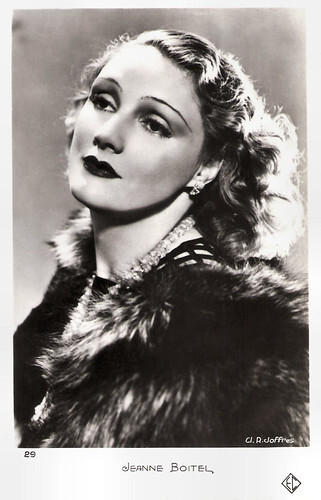
French postcard by Edition Chantal, no. 29. Photo: R. Joffres.
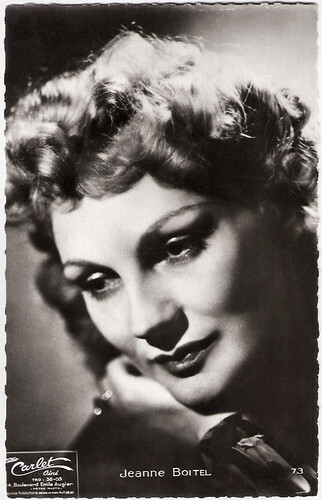
French postcard, no. 73. Photo: Carlet Ainé, Paris.
A refined grande dame
Jeanne Marie Andrée Boitel was born in Paris in 1904. Boitel had a passion for the theatre - she was on stage from the age of 19 - and studied at the Paris Conservatoire, graduating in 1924. After a fine start in her career as a stage actress, her beauty and singing talent were discovered by film directors.
She made her first film in Berlin, Le petit écart/The Small Gap (1932), co-directed by Henri Chomette, René Clair's older brother, and the German actor and filmmaker Reinhold Schünzel . Her partner was Pierre Richard-Willm , whom she reunited with in Un soir au front/One Evening at the Front (Alexandre Ryder, 1931) based on the play by Belgian playwright Henri Kistemaeckers. She played a young woman in Alsace, still annexed to the German Empire, who saves and loves a French officer but remains faithful to her German husband.
That same year, she starred opposite Victor Francen , the loyal servant of the Duke of Reichstadt, in L'aiglon/The Eagle (Victor Tourjansky, 1931) written by Edmond Rostand. She ended the year with boulevard comedies, including L'amoureuse aventure/Amorous Adventure (Wilhelm Thiele, 1931) starring Albert Préjean .
The year 1932 remained just as active with Chotard et Cie/Chotard and Company (Jean Renoir, 1934), in which Fernand Charpin prevents his daughter's marriage to a budding writer, and Trois pour cent/Three per cent (Jean Dréville, 1934), in which the parents of a poor young man prevent his marriage to a rich girl!
She reunited with Reinhold Schünzel in Berlin for Les dieux s'amusent/The Gods at Play (Reinhold Schünzel, Albert Valentin, 1934), a musical based on Greek mythology, in which Jeanne was a very pretty Alcmène, wife of Amphitryon, alias Henri Garat . She was also very convincing as Madame de Pompadour in Sacha Guitry 's Remontons les Champs-Élysées/Let's Go Up the Champs-Élysées (1938). During the 1930s, she made around thirty films and worked with some of the biggest names in French cinema. Her natural distinction destined her - and confined her - to the role of a refined grande dame.
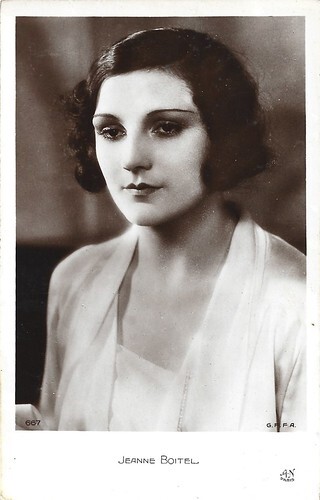
French postcard by A.N., Paris, no. 667. Photo: G.P.F.A.
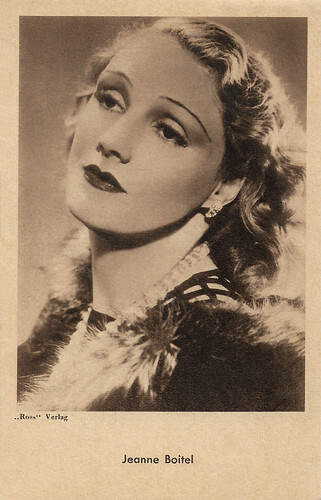
German postcard for Das Programma von Heute by Ross Verlag.
Madame Maigret
After the Occupation, Jeanne Boitel refused to compromise with the Germans, who controlled all cinema from 1940 to 1944, and returned to her original passion for theatre while working for the Resistance.
Through her involvement in the Resistance, she met Jacques Jaujard, curator of the Louvre Museum. Under the code name of "Mozart", she was sent to him to inventory and discuss the fate of the works he had hidden. They fell in love and married after the war, following Jaujard's divorce. After the war, Jeanne Boitel became a Sociétaire of the Comédie-Française. She considered herself too old to resume her film career where she had left off. She remained at the Comédie Française from 1948 to 1973.
In 1954, she made a modest return to the cinema for Sacha Guitry . He had directed her in Remontons les Champs-Élysées before the war and had fond memories of her. He courted her and finally persuaded her to take the part of Madame de Sévigné in the film Si Versailles m'était conté/Royal Affairs in Versailles (Sacha Guitry, 1953), followed by roles as the Duchesse de Dino in Napoléon (Sacha Guitry, 1954) with Raymond Pellegrin in the title role, before playing Sarah Bernhardt in Si Paris m'était conté/If Paris Were Told to Us (Sacha Guitry, 1955).
Her last screen appearance was as Madame Maigret in Maigret Tend un piège/Maigret Lays a Trap (Jean Delannoy, 1957), alongside Jean Gabin as George Simenon's famous police detective. This role brought her lasting fame, as for a long time she was the only Madame Maigret in cinema.
After one last small role in the television series Le neveu d'Amérique (1973), she retired from acting at the age of 70. Her courage during the Resistance earned her the Croix de Guerre, the Rosette de la Résistance and the Légion d'Honneur. Jeanne Boitel passed away in 1987 in her hometown Paris at the age of 83. She had a son with Jacques Jaujard, François-Xavier Jaujard (1946-1996), a translator and publisher.
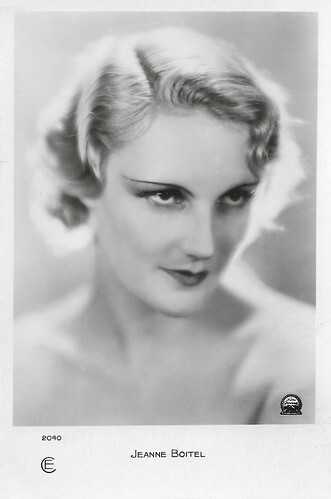
French postcard by CE - Cinémagazine Selection, Paris, no. 2040. Photo: Les Films Paramount.
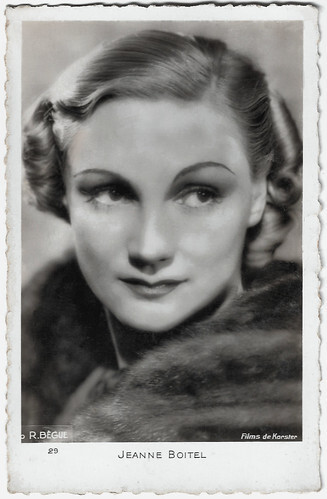
French postcard, no. 29. Photo: R. Bègue / Films de Koster. Jeanne Boitel in Ceux de demain/Those of tomorrow (Adelqui Migliar, George Pallu, 1938).
Sources: Caroline Hanotte (CinéArtistes - French), Wikipedia (French and English) and .

French postcard by Edition Chantal, no. 29. Photo: R. Joffres.

French postcard, no. 73. Photo: Carlet Ainé, Paris.
A refined grande dame
Jeanne Marie Andrée Boitel was born in Paris in 1904. Boitel had a passion for the theatre - she was on stage from the age of 19 - and studied at the Paris Conservatoire, graduating in 1924. After a fine start in her career as a stage actress, her beauty and singing talent were discovered by film directors.
She made her first film in Berlin, Le petit écart/The Small Gap (1932), co-directed by Henri Chomette, René Clair's older brother, and the German actor and filmmaker Reinhold Schünzel . Her partner was Pierre Richard-Willm , whom she reunited with in Un soir au front/One Evening at the Front (Alexandre Ryder, 1931) based on the play by Belgian playwright Henri Kistemaeckers. She played a young woman in Alsace, still annexed to the German Empire, who saves and loves a French officer but remains faithful to her German husband.
That same year, she starred opposite Victor Francen , the loyal servant of the Duke of Reichstadt, in L'aiglon/The Eagle (Victor Tourjansky, 1931) written by Edmond Rostand. She ended the year with boulevard comedies, including L'amoureuse aventure/Amorous Adventure (Wilhelm Thiele, 1931) starring Albert Préjean .
The year 1932 remained just as active with Chotard et Cie/Chotard and Company (Jean Renoir, 1934), in which Fernand Charpin prevents his daughter's marriage to a budding writer, and Trois pour cent/Three per cent (Jean Dréville, 1934), in which the parents of a poor young man prevent his marriage to a rich girl!
She reunited with Reinhold Schünzel in Berlin for Les dieux s'amusent/The Gods at Play (Reinhold Schünzel, Albert Valentin, 1934), a musical based on Greek mythology, in which Jeanne was a very pretty Alcmène, wife of Amphitryon, alias Henri Garat . She was also very convincing as Madame de Pompadour in Sacha Guitry 's Remontons les Champs-Élysées/Let's Go Up the Champs-Élysées (1938). During the 1930s, she made around thirty films and worked with some of the biggest names in French cinema. Her natural distinction destined her - and confined her - to the role of a refined grande dame.

French postcard by A.N., Paris, no. 667. Photo: G.P.F.A.

German postcard for Das Programma von Heute by Ross Verlag.
Madame Maigret
After the Occupation, Jeanne Boitel refused to compromise with the Germans, who controlled all cinema from 1940 to 1944, and returned to her original passion for theatre while working for the Resistance.
Through her involvement in the Resistance, she met Jacques Jaujard, curator of the Louvre Museum. Under the code name of "Mozart", she was sent to him to inventory and discuss the fate of the works he had hidden. They fell in love and married after the war, following Jaujard's divorce. After the war, Jeanne Boitel became a Sociétaire of the Comédie-Française. She considered herself too old to resume her film career where she had left off. She remained at the Comédie Française from 1948 to 1973.
In 1954, she made a modest return to the cinema for Sacha Guitry . He had directed her in Remontons les Champs-Élysées before the war and had fond memories of her. He courted her and finally persuaded her to take the part of Madame de Sévigné in the film Si Versailles m'était conté/Royal Affairs in Versailles (Sacha Guitry, 1953), followed by roles as the Duchesse de Dino in Napoléon (Sacha Guitry, 1954) with Raymond Pellegrin in the title role, before playing Sarah Bernhardt in Si Paris m'était conté/If Paris Were Told to Us (Sacha Guitry, 1955).
Her last screen appearance was as Madame Maigret in Maigret Tend un piège/Maigret Lays a Trap (Jean Delannoy, 1957), alongside Jean Gabin as George Simenon's famous police detective. This role brought her lasting fame, as for a long time she was the only Madame Maigret in cinema.
After one last small role in the television series Le neveu d'Amérique (1973), she retired from acting at the age of 70. Her courage during the Resistance earned her the Croix de Guerre, the Rosette de la Résistance and the Légion d'Honneur. Jeanne Boitel passed away in 1987 in her hometown Paris at the age of 83. She had a son with Jacques Jaujard, François-Xavier Jaujard (1946-1996), a translator and publisher.

French postcard by CE - Cinémagazine Selection, Paris, no. 2040. Photo: Les Films Paramount.

French postcard, no. 29. Photo: R. Bègue / Films de Koster. Jeanne Boitel in Ceux de demain/Those of tomorrow (Adelqui Migliar, George Pallu, 1938).
Sources: Caroline Hanotte (CinéArtistes - French), Wikipedia (French and English) and .
Published on August 15, 2023 22:00
August 14, 2023
Lila Lee
Lila Lee (1901-1973) was a prominent screen actress, primarily a leading lady, of the silent film and early sound film eras.
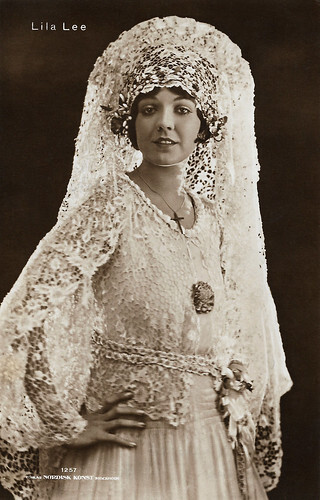
Swedish postcard by Nordisk Konst, Stockholm, no. 1257. Lila Lee in Blood and Sand (Fred Niblo, Dorothy Arzner, 1922).
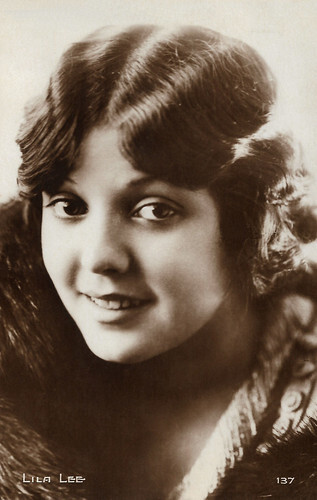
French postcard, no. 137. Sent by mail in 1929.
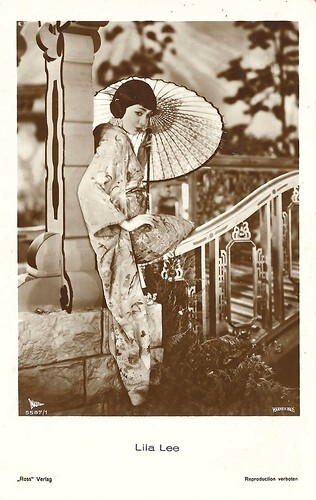
German postcard by Ross Verlag, Berlin, no. 5587/1, 1930-1931. Photo: National Film / Warner Bros. Probably publicity still for Murder Will Out (Clarence G. Badger, 1930).
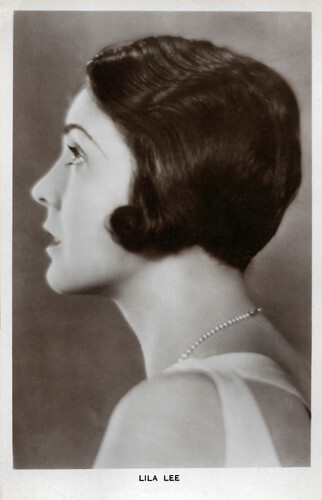
British postcard in the Picturegoer Series, London, no. 186b.
Her wholesome persona and sympathetic character parts
Lila Lee was born Augusta Wilhelmena Fredericka Appel in Union Hill, New Jersey, in 1901. She was the daughter of two German immigrants, Augusta Fredericka Appel and Carl Appel.
She was a performer since childhood in Gus Edwards' kiddie review shows and was given the nickname "Cuddles", a name that she would be known by for the rest of her acting career. Lee performed in vaudeville for eight years.
In 1918, she was chosen for a film contract by Hollywood film mogul Jesse Lasky for Famous Players-Lasky Corporation, which later became Paramount Pictures. She was launched by Lasky in a big campaign. She debuted in a starring role with The Cruise of the Make-Believes (1918) as a poor girl supported by a rich admirer. Then followed her appearance as a servant wench in Cecil B. DeMille 's Male and Female (1919)
Critics lauded Lila for her wholesome persona and sympathetic character parts. Lee quickly rose to the ranks of leading lady and often starred opposite such matinee heavies as Conrad Nagel , Gloria Swanson , Wallace Reid, Roscoe 'Fatty' Arbuckle , and Rudolph Valentino .
In 1922, Lee was cast as Carmen in the enormously popular film Blood and Sand (Fred Niblo, Dorothy Arzner, 1922), opposite matinee idol Rudolph Valentino and silent screen vamp Nita Naldi . Lila Lee subsequently won the first WAMPAS Baby Stars award that year.
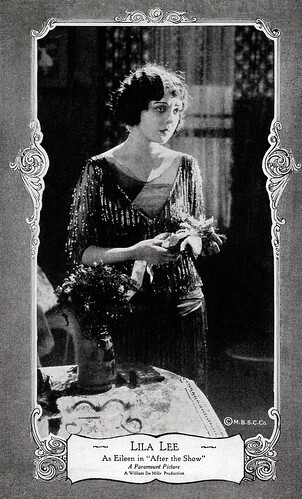
American postcard by M.B.S.C. Co. (Max B. Sheffer Card Co, Chicago), 1922. Photo: William de Mille / Paramount. Lila Lee as Eileen in After the Show (William C. de Mille, 1921).
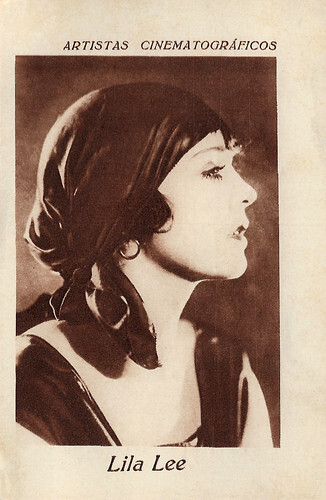
Spanish collectors card in the Artistas Cinemátograficos series. Photo: Paramount. Lila Lee in Blood and Sand (Fred Niblo, Dorothy Arzner, 1922).
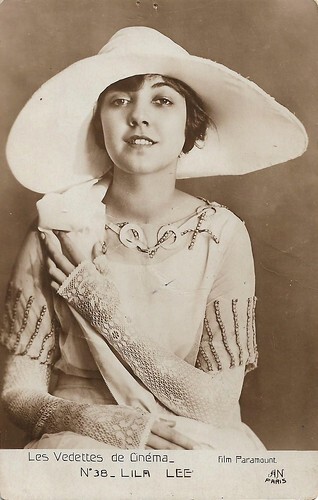
French postcard by A.N., Paris in the Les vedettes de cinéma series, no. 38. Photo: Film Paramount.
Bad choices, tuberculosis and alcoholism
Lila Lee continued to be a highly popular leading lady throughout the 1920s and made scores of critically praised and widely watched films. These included the drama Another Man's Wife (Bruce Mitchell, 1924) and the romantic comedy The Adorable Cheat (Burton L. King, 1928).
By the late 1920s, she was well prepared for the arrival of the talkies. She appeared, most notably, in The Unholy Three (Jack Conway, 1930), opposite Lon Chaney Sr. in his only sound film.
However, bad choices, tuberculosis and alcoholism had her career going downwards in the 1930s, reduced to B-movies. In the 1940s she acted on stage, in the 1950s she was in soap operas on TV. The obscure comedy Cottonpickin' Chickenpickers (Larry E. Jackson, 1967) was her final film.
Lee's first husband (of three) was actor/director James Kirkwood Senior, whom she married in 1923. They had met on the set of Ebb Tide in 1922. Their son was playwright and screenwriter James Kirkwood Junior (1924–1989). During the divorce, the father was given custody of the son.
After Kirkwood Sr., Lee was married to two brokers, Jack R. Peine and John E. Murphy, but both marriages ended in divorce, just like the first one. Lila Lee died of a stroke in 1973 in Saranac Lake, New York.
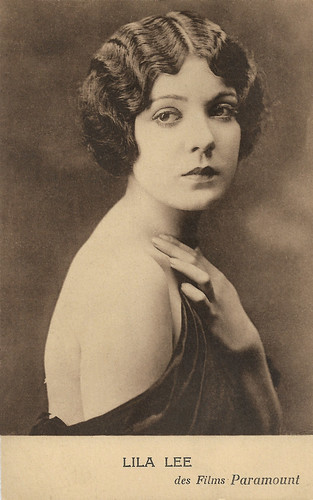
French postcard by Editions Paramount, Paris.
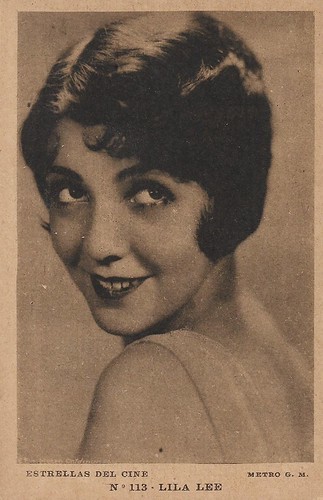
Spanish postcard in the Estrellas del cine series by Editorial Grafica, Barcelona, no. 113. Photo: Metro-Goldwyn-Mayer.
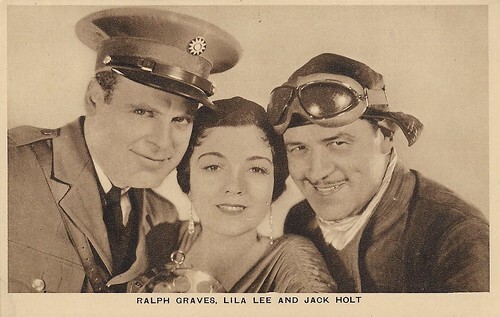
Vintage collector's card. Photo: Columbia. Jack Holt , Lila Lee and Ralph Graves in Flight (Frank Capra, 1929).
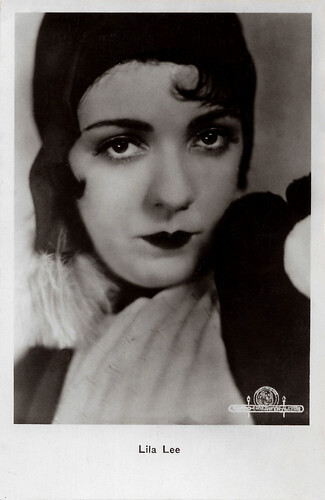
Belgian postcard by P.I.A. Belga phot., Bruxelles. Photo: Metro-Goldwyn-Mayer.
Sources: (IMDb), Wikipedia (English and German), and .

Swedish postcard by Nordisk Konst, Stockholm, no. 1257. Lila Lee in Blood and Sand (Fred Niblo, Dorothy Arzner, 1922).

French postcard, no. 137. Sent by mail in 1929.

German postcard by Ross Verlag, Berlin, no. 5587/1, 1930-1931. Photo: National Film / Warner Bros. Probably publicity still for Murder Will Out (Clarence G. Badger, 1930).

British postcard in the Picturegoer Series, London, no. 186b.
Her wholesome persona and sympathetic character parts
Lila Lee was born Augusta Wilhelmena Fredericka Appel in Union Hill, New Jersey, in 1901. She was the daughter of two German immigrants, Augusta Fredericka Appel and Carl Appel.
She was a performer since childhood in Gus Edwards' kiddie review shows and was given the nickname "Cuddles", a name that she would be known by for the rest of her acting career. Lee performed in vaudeville for eight years.
In 1918, she was chosen for a film contract by Hollywood film mogul Jesse Lasky for Famous Players-Lasky Corporation, which later became Paramount Pictures. She was launched by Lasky in a big campaign. She debuted in a starring role with The Cruise of the Make-Believes (1918) as a poor girl supported by a rich admirer. Then followed her appearance as a servant wench in Cecil B. DeMille 's Male and Female (1919)
Critics lauded Lila for her wholesome persona and sympathetic character parts. Lee quickly rose to the ranks of leading lady and often starred opposite such matinee heavies as Conrad Nagel , Gloria Swanson , Wallace Reid, Roscoe 'Fatty' Arbuckle , and Rudolph Valentino .
In 1922, Lee was cast as Carmen in the enormously popular film Blood and Sand (Fred Niblo, Dorothy Arzner, 1922), opposite matinee idol Rudolph Valentino and silent screen vamp Nita Naldi . Lila Lee subsequently won the first WAMPAS Baby Stars award that year.

American postcard by M.B.S.C. Co. (Max B. Sheffer Card Co, Chicago), 1922. Photo: William de Mille / Paramount. Lila Lee as Eileen in After the Show (William C. de Mille, 1921).

Spanish collectors card in the Artistas Cinemátograficos series. Photo: Paramount. Lila Lee in Blood and Sand (Fred Niblo, Dorothy Arzner, 1922).

French postcard by A.N., Paris in the Les vedettes de cinéma series, no. 38. Photo: Film Paramount.
Bad choices, tuberculosis and alcoholism
Lila Lee continued to be a highly popular leading lady throughout the 1920s and made scores of critically praised and widely watched films. These included the drama Another Man's Wife (Bruce Mitchell, 1924) and the romantic comedy The Adorable Cheat (Burton L. King, 1928).
By the late 1920s, she was well prepared for the arrival of the talkies. She appeared, most notably, in The Unholy Three (Jack Conway, 1930), opposite Lon Chaney Sr. in his only sound film.
However, bad choices, tuberculosis and alcoholism had her career going downwards in the 1930s, reduced to B-movies. In the 1940s she acted on stage, in the 1950s she was in soap operas on TV. The obscure comedy Cottonpickin' Chickenpickers (Larry E. Jackson, 1967) was her final film.
Lee's first husband (of three) was actor/director James Kirkwood Senior, whom she married in 1923. They had met on the set of Ebb Tide in 1922. Their son was playwright and screenwriter James Kirkwood Junior (1924–1989). During the divorce, the father was given custody of the son.
After Kirkwood Sr., Lee was married to two brokers, Jack R. Peine and John E. Murphy, but both marriages ended in divorce, just like the first one. Lila Lee died of a stroke in 1973 in Saranac Lake, New York.

French postcard by Editions Paramount, Paris.

Spanish postcard in the Estrellas del cine series by Editorial Grafica, Barcelona, no. 113. Photo: Metro-Goldwyn-Mayer.

Vintage collector's card. Photo: Columbia. Jack Holt , Lila Lee and Ralph Graves in Flight (Frank Capra, 1929).

Belgian postcard by P.I.A. Belga phot., Bruxelles. Photo: Metro-Goldwyn-Mayer.
Sources: (IMDb), Wikipedia (English and German), and .
Published on August 14, 2023 22:00
August 13, 2023
Dina Galli
Dina Galli (1877-1951) was a legendary Italian comedienne who conquered the Italian stage with her flashing but gentle eyes and a particular face. She also was successful in several Italian silent and sound films and became one of Federico Fellini's favourite actresses.
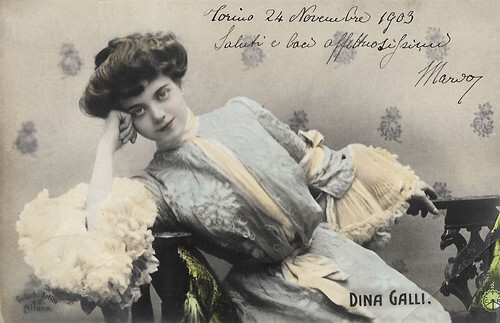
Italian postcard by CR / Diffida ASC, no. 2. Photo: Varischi Artico & C., Milano. Sent by mail in 1903.
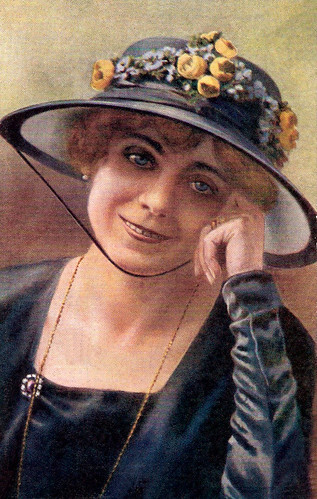
Italian postcard by ENCV.
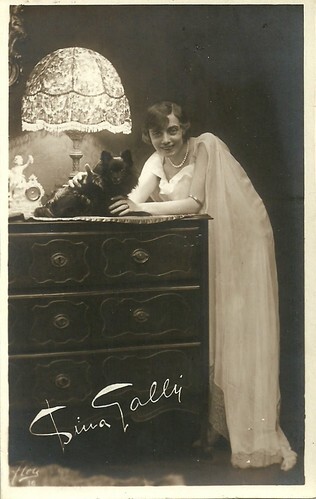
Italian postcard by Unione Bromografica, Milano, no. 16.
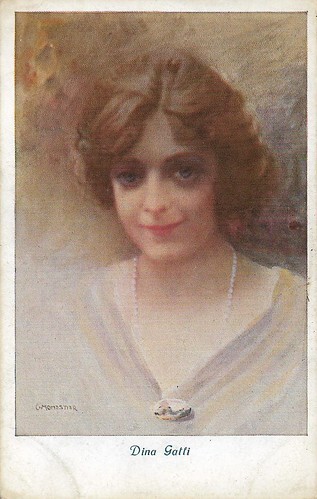
Italian postcard by G.B. Falci, Milano, Series 212. Portrait by C. Monestier.
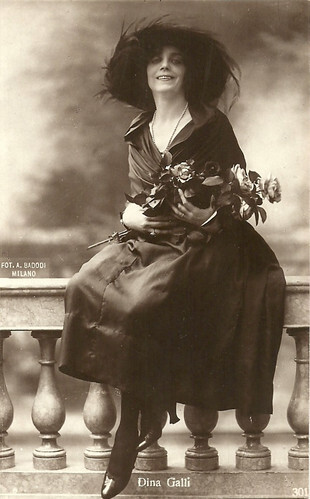
Italian postcard by Ed. A. Traldi, Milano, no. 301. Photo: A. Badodi, Milano.
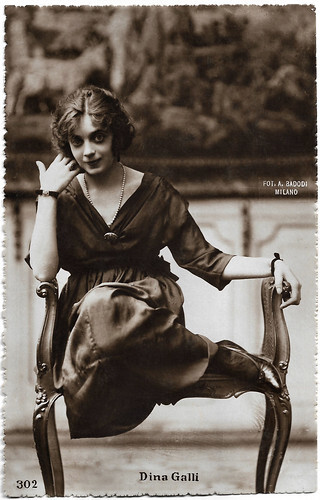
Italian postcard by Ed. A. Traldi, Milano, no. 302. Photo: A. Badodi, Milano.
Flashing blue eyes
Dina Galli was born as Clotilde Annamaria Galli in Milan, Italy in 1877. She was a real figlia d'arte. Her mother was an actress and as a little girl, Dina already played small parts for her mother's theatre companies.
With her flashing blue eyes, her pointed face, her slender figure and her gentle irony, she soon conquered the Italian stage. In 1890, she joined the theatre company of Edoardo Ferravilla, the great actor of the Milanese dialect. There she showed a great talent for comedy and soon she played leading roles.
A decade later she managed to enter the renowned Talli-Grammatica-Calabresi theatre company with the young Ruggero Ruggeri . For years she excelled in the frivolous and spicy comedies by Georges Feydeau, Maurice Hennequin, Pierre Veber et. al., such as 'La Dame de chez Maxim'.
La Dina became the darling of both the critics and the public. During the First World War, she obtained successes with 'La Maestrina' (The Teacher) and 'Scampolo', both by Dario Niccodemi. Galli took sidesteps into the silent cinema during the First World War and appeared in Veli di giovinezza/Veils of Youth (1914), La monella/The Brat (1914) and L'ammiraglia/The Flagship (1915). All three films were directed by Nino Oxilia, who was killed during the war.
In 1917 followed Le nozze di Vittoria/The Wedding of Victoria (Ugo Falena, 1917). After that, Galli focused on dramatic roles in stage plays, in particular the dialectical theatre by Giuseppe Adami. In these productions, Galli talked in vernacular Milanese, as in 'Felicita Colombo' (1935), the role that stuck to her.
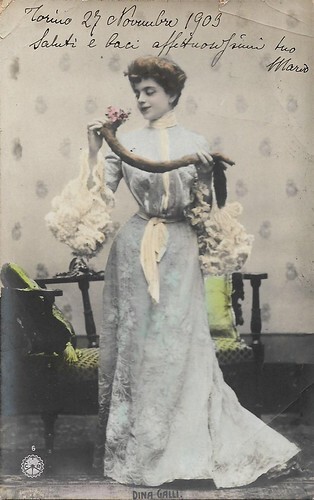
Italian postcard by ASC Diffida / CR, no. 6. Sent by mail on 27 November 1903.
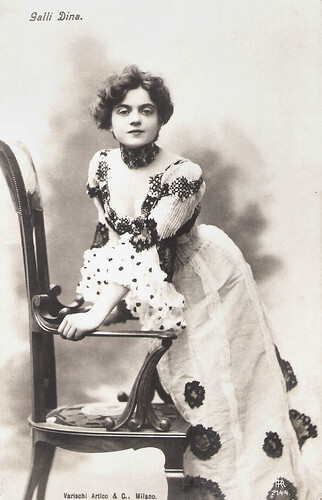
Italian postcard by RA, no. 2144. Photo: Varischi Artico & C., Milano.
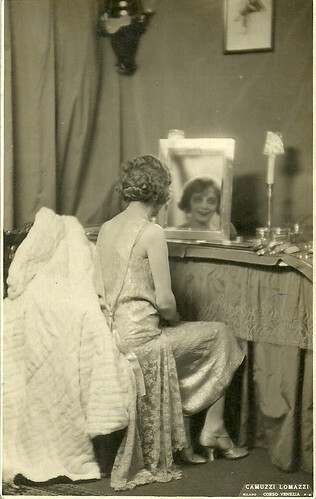
Italian postcard by LTK. Photo: Camuzzi Lomazzi, Corso Venezia, Milano.
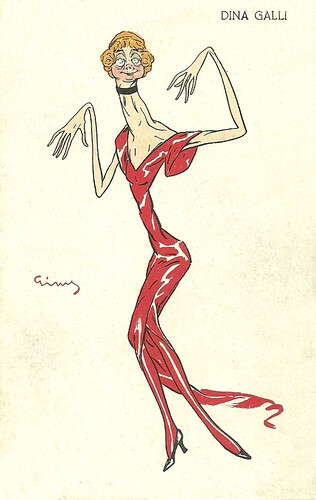
Italian postcard. Caricature by Girus (Giuseppe Russo). It was exposed in 1914 at the first international exhibition of caricatures and humorism in Italy.
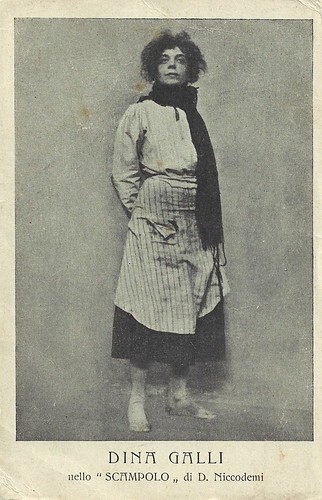
Italian postcard by Tip. Teatr. & Comm., Torino, Dina Galli in the play 'Scampolo' (1915) by Dario Niccodemi. The painter Carlo Stratta would paint a portrait of Galli based on the photo for this card. Niccodemi would write a novel (1918) based on the play, while several film adaptations would follow with a.o. Carmen Boni and Romy Schneider .
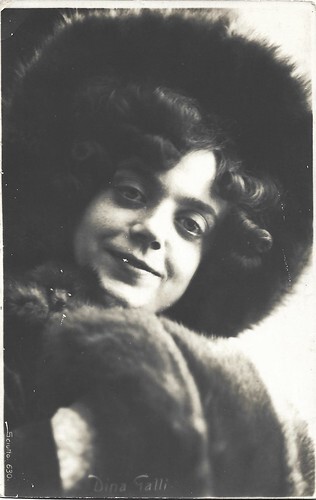
Italian postcard, no. 630. Photo: Sciutto, no. 630.
One of Fellini's favourite actresses
From the late 1930s on, Dina Galli regularly acted in the Italian sound cinema. The films Felicita Colombo (Mario Mattoli, 1937) and Nonna Felicita/Grandmother Felicita (Mario Mattoli, 1938) with Armando Falconi were both based on the stage successes of Galli and showed her comedy skills.
Other films she played in were Nini Falpalà (Amleto Palermi, 1933), Frenesia/Frenzy (Mario Bonnard, 1939), La zia smemorata/The Forgetful Aunt (Ladislao Vajda, 1941), and Il sogno di tutti/The Dream of Everything (Oreste Biancoli, Laszlo Kish, 1941).
Then followed Stasera niente di nuovo/Nothing new tonight (Mario Mattoli, 1942) with Carlo Ninchi and Alida Valli , I biricchino di papà/The fluffy Dad (Raffaele Matarazzo, 1943), and Tre ragazze cercano marito/Three Girls Looking for Husbands (Duilio Coletti, 1944) with Carla del Poggio .
After the war, she acted in Lo sbaglio di essere vivo/My Widow and I (Carlo Ludovico Bragaglia, 1945) starring Vittorio De Sica and Isa Miranda , Vanità/Vanity (Giorgio Pastina, 1946), and Sambo (Paolo William Tamburalla, 1950) with Paolo Stoppa . Her last, uncredited, role was in I cadetti di Gascogna/The Cadets of Gascony (Mario Mattoli, 1950) starring Walter Chiari . In 1945, Galli returned to the stage with comedies such as Noel Coward's 'Blythe Spirit' by George Kaufman and Moss Hart, together with Rina Morelli, and 'Arsenic and Old Lace' by Kesserling.
She was one of Federico Fellini 's favourite actresses. Her last performance was in the revue 'Quo Vadis? (1950), with Enrico Viarisio . Dina Galli died in Rome in 1951. She was 73. In 2022, Mariagabriella Cambiaghi and Raffaele De Berti published a new, Italian study on Galli, 'L'ambrosiana pura. Dina Galli attrice di teatro, cinema e radio' (Mimesis Edizioni).
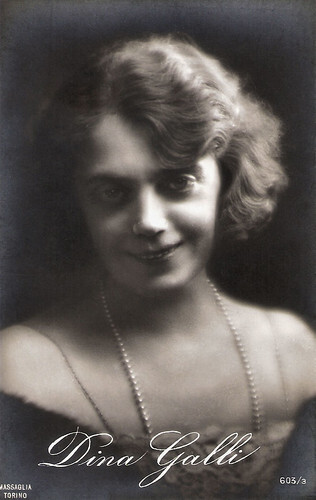
Italian postcard by G. Ballerini & C. Editori, Firenze, no. 603/3. Photo: Massaglia, Torino.
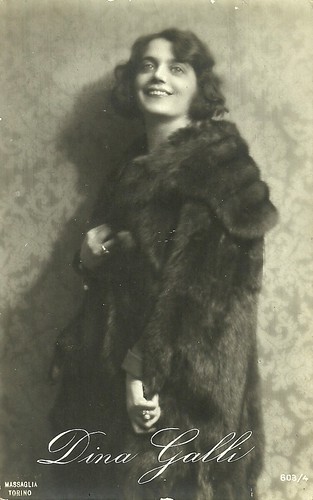
Italian postcard by G. Ballerini & C. Editori, Firenze. no. 603/4. Photo: Massaglia, Torino.
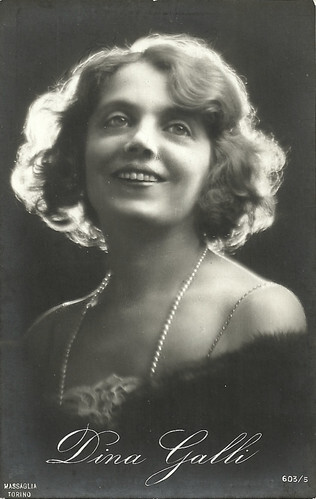
Italian postcard by G. Ballerini & C. Editori, Firenze. no. 603/5. Photo: Massaglia, Torino.
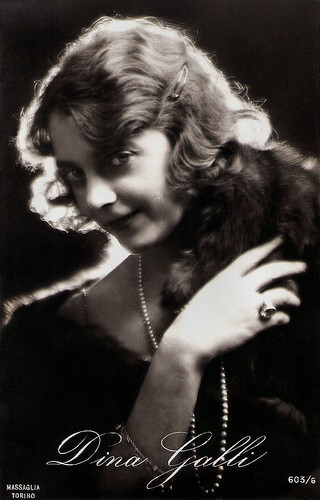
Italian postcard by G. Ballerini & C. Editori, Firenze, no. 603/6. Photo: Massaglia, Torino.
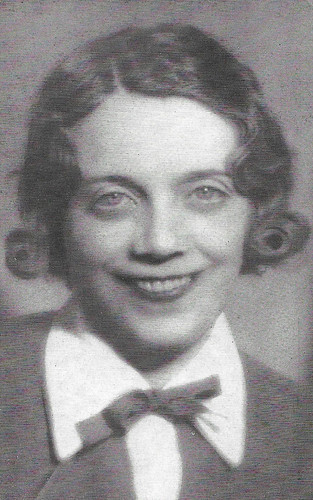
Italian postcard.
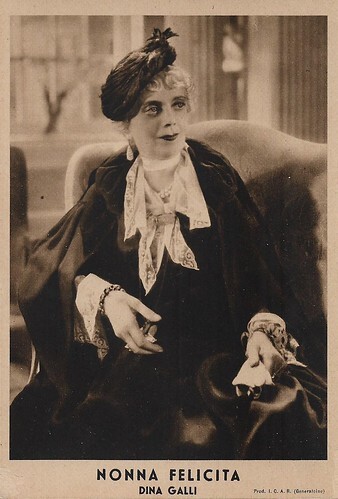
Italian postcard by I.C.A.R. (Generalcine). Dina Galli in the Italian comedy Nonna Felicità (Mario Mattoli, 1938). It was a sequel to the 1937 film Felicità Colombo, again by Mattoli.
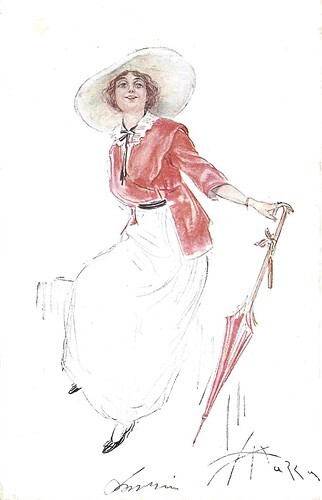
Italian postcard by Alfieri & Lacroix, Milano, no. 1810. Design by Aldo Mazza.
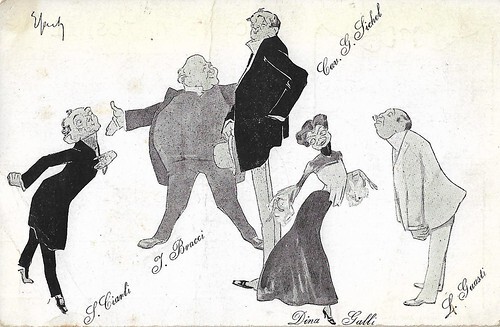
Vintage Italian postcard by Societa' Editricie Cartoline, Torino. Caricature by Efenty [?] of the stage company Sichel Galli Guasti, led by cav. Giuseppe Sichel, Dina Galli and Amerigo [the L. on this card is an error] Guasti. Also visible on this card: Ignazio Bracci and Stanislao Ciarli. In 1906-1907, Sichel formed this company, named Compagnia dei cinque, which was one of the most significant in Italy at the time.
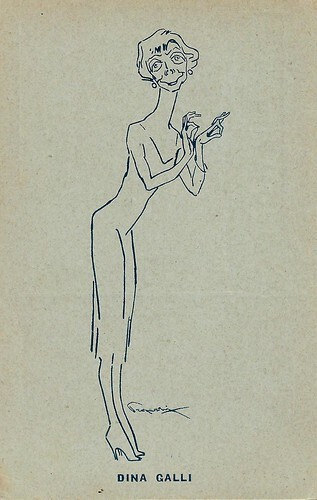
.Italian postcard, edited by the journal Le Maschere. Caricature by Sandro Properzi.
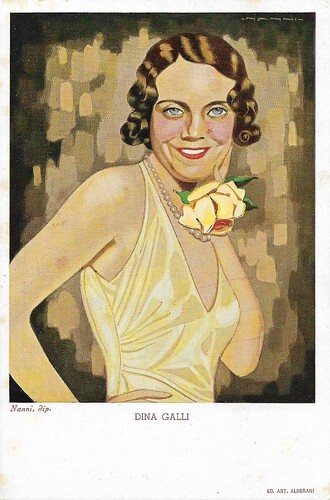
Italian postcard by Ed. Art. Alberani (Frutta Alberani). Design by Nanni.
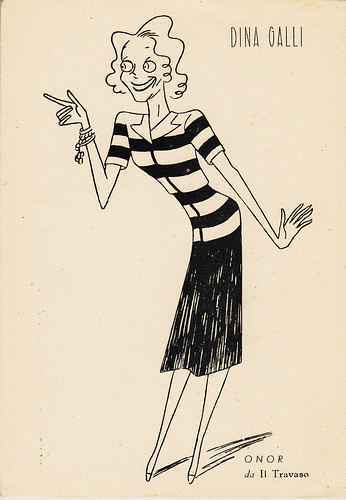
Italian postcard by I.G.A.P. Roma. Caricature by Onor. Collection: Marlene Pilaete.
A segment of Luce Journal after the death and funeral of Dina Galli in 1951. Source: CinecittaLuce (YouTube).
Sources: Sipario.it (Italian), Mymovies.it (Italian), Wikipedia (Italian) and .

Italian postcard by CR / Diffida ASC, no. 2. Photo: Varischi Artico & C., Milano. Sent by mail in 1903.

Italian postcard by ENCV.

Italian postcard by Unione Bromografica, Milano, no. 16.

Italian postcard by G.B. Falci, Milano, Series 212. Portrait by C. Monestier.

Italian postcard by Ed. A. Traldi, Milano, no. 301. Photo: A. Badodi, Milano.

Italian postcard by Ed. A. Traldi, Milano, no. 302. Photo: A. Badodi, Milano.
Flashing blue eyes
Dina Galli was born as Clotilde Annamaria Galli in Milan, Italy in 1877. She was a real figlia d'arte. Her mother was an actress and as a little girl, Dina already played small parts for her mother's theatre companies.
With her flashing blue eyes, her pointed face, her slender figure and her gentle irony, she soon conquered the Italian stage. In 1890, she joined the theatre company of Edoardo Ferravilla, the great actor of the Milanese dialect. There she showed a great talent for comedy and soon she played leading roles.
A decade later she managed to enter the renowned Talli-Grammatica-Calabresi theatre company with the young Ruggero Ruggeri . For years she excelled in the frivolous and spicy comedies by Georges Feydeau, Maurice Hennequin, Pierre Veber et. al., such as 'La Dame de chez Maxim'.
La Dina became the darling of both the critics and the public. During the First World War, she obtained successes with 'La Maestrina' (The Teacher) and 'Scampolo', both by Dario Niccodemi. Galli took sidesteps into the silent cinema during the First World War and appeared in Veli di giovinezza/Veils of Youth (1914), La monella/The Brat (1914) and L'ammiraglia/The Flagship (1915). All three films were directed by Nino Oxilia, who was killed during the war.
In 1917 followed Le nozze di Vittoria/The Wedding of Victoria (Ugo Falena, 1917). After that, Galli focused on dramatic roles in stage plays, in particular the dialectical theatre by Giuseppe Adami. In these productions, Galli talked in vernacular Milanese, as in 'Felicita Colombo' (1935), the role that stuck to her.

Italian postcard by ASC Diffida / CR, no. 6. Sent by mail on 27 November 1903.

Italian postcard by RA, no. 2144. Photo: Varischi Artico & C., Milano.

Italian postcard by LTK. Photo: Camuzzi Lomazzi, Corso Venezia, Milano.

Italian postcard. Caricature by Girus (Giuseppe Russo). It was exposed in 1914 at the first international exhibition of caricatures and humorism in Italy.

Italian postcard by Tip. Teatr. & Comm., Torino, Dina Galli in the play 'Scampolo' (1915) by Dario Niccodemi. The painter Carlo Stratta would paint a portrait of Galli based on the photo for this card. Niccodemi would write a novel (1918) based on the play, while several film adaptations would follow with a.o. Carmen Boni and Romy Schneider .

Italian postcard, no. 630. Photo: Sciutto, no. 630.
One of Fellini's favourite actresses
From the late 1930s on, Dina Galli regularly acted in the Italian sound cinema. The films Felicita Colombo (Mario Mattoli, 1937) and Nonna Felicita/Grandmother Felicita (Mario Mattoli, 1938) with Armando Falconi were both based on the stage successes of Galli and showed her comedy skills.
Other films she played in were Nini Falpalà (Amleto Palermi, 1933), Frenesia/Frenzy (Mario Bonnard, 1939), La zia smemorata/The Forgetful Aunt (Ladislao Vajda, 1941), and Il sogno di tutti/The Dream of Everything (Oreste Biancoli, Laszlo Kish, 1941).
Then followed Stasera niente di nuovo/Nothing new tonight (Mario Mattoli, 1942) with Carlo Ninchi and Alida Valli , I biricchino di papà/The fluffy Dad (Raffaele Matarazzo, 1943), and Tre ragazze cercano marito/Three Girls Looking for Husbands (Duilio Coletti, 1944) with Carla del Poggio .
After the war, she acted in Lo sbaglio di essere vivo/My Widow and I (Carlo Ludovico Bragaglia, 1945) starring Vittorio De Sica and Isa Miranda , Vanità/Vanity (Giorgio Pastina, 1946), and Sambo (Paolo William Tamburalla, 1950) with Paolo Stoppa . Her last, uncredited, role was in I cadetti di Gascogna/The Cadets of Gascony (Mario Mattoli, 1950) starring Walter Chiari . In 1945, Galli returned to the stage with comedies such as Noel Coward's 'Blythe Spirit' by George Kaufman and Moss Hart, together with Rina Morelli, and 'Arsenic and Old Lace' by Kesserling.
She was one of Federico Fellini 's favourite actresses. Her last performance was in the revue 'Quo Vadis? (1950), with Enrico Viarisio . Dina Galli died in Rome in 1951. She was 73. In 2022, Mariagabriella Cambiaghi and Raffaele De Berti published a new, Italian study on Galli, 'L'ambrosiana pura. Dina Galli attrice di teatro, cinema e radio' (Mimesis Edizioni).

Italian postcard by G. Ballerini & C. Editori, Firenze, no. 603/3. Photo: Massaglia, Torino.

Italian postcard by G. Ballerini & C. Editori, Firenze. no. 603/4. Photo: Massaglia, Torino.

Italian postcard by G. Ballerini & C. Editori, Firenze. no. 603/5. Photo: Massaglia, Torino.

Italian postcard by G. Ballerini & C. Editori, Firenze, no. 603/6. Photo: Massaglia, Torino.

Italian postcard.

Italian postcard by I.C.A.R. (Generalcine). Dina Galli in the Italian comedy Nonna Felicità (Mario Mattoli, 1938). It was a sequel to the 1937 film Felicità Colombo, again by Mattoli.

Italian postcard by Alfieri & Lacroix, Milano, no. 1810. Design by Aldo Mazza.

Vintage Italian postcard by Societa' Editricie Cartoline, Torino. Caricature by Efenty [?] of the stage company Sichel Galli Guasti, led by cav. Giuseppe Sichel, Dina Galli and Amerigo [the L. on this card is an error] Guasti. Also visible on this card: Ignazio Bracci and Stanislao Ciarli. In 1906-1907, Sichel formed this company, named Compagnia dei cinque, which was one of the most significant in Italy at the time.

.Italian postcard, edited by the journal Le Maschere. Caricature by Sandro Properzi.

Italian postcard by Ed. Art. Alberani (Frutta Alberani). Design by Nanni.

Italian postcard by I.G.A.P. Roma. Caricature by Onor. Collection: Marlene Pilaete.
A segment of Luce Journal after the death and funeral of Dina Galli in 1951. Source: CinecittaLuce (YouTube).
Sources: Sipario.it (Italian), Mymovies.it (Italian), Wikipedia (Italian) and .
Published on August 13, 2023 22:00
August 12, 2023
Ludwig Schmitz
Ludwig Schmitz (1996-1953) was a short, stocky character comedian, who often appeared as comic support in German films of the 1930s. In 1939 and 1940, he and Jupp Hussels impersonated the pair Tran und Helle, who had countless entrances in short films which were shown as a contribution to the Wochenschau. He fell foul of the regime in 1941 and did not make a comeback until 1950.
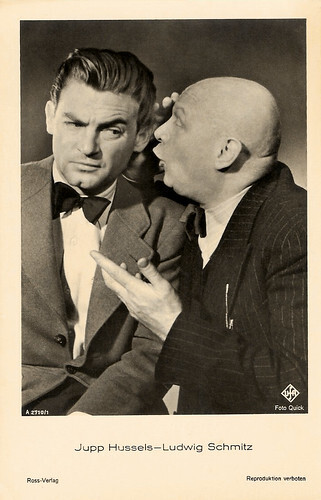
German postcard by Ross Verlag, no A 2710/1, 1939-1940. Photo: Quick / Ufa.
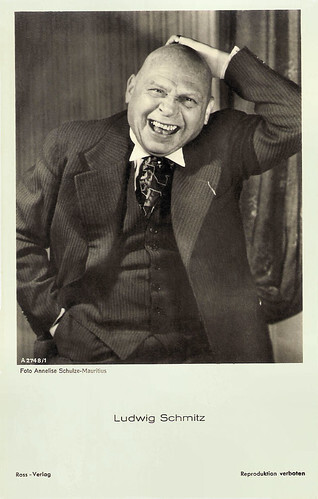
German postcard by Ross Verlag, no. A 2748/1, 1939-1940. Photo: Annelise Schulze-Mauritius.
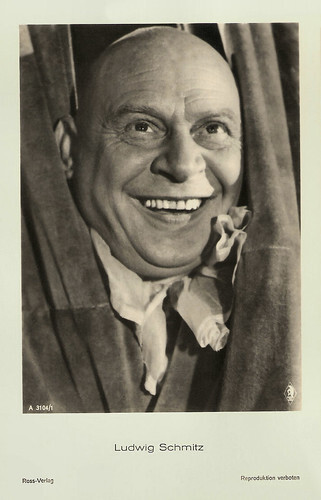
German postcard by Ross Verlag, no. A 3104/1, 1941-1944. Photo: Bavaria-Filmkunst. Ludwig Schmitz in Komödianten/The Comedians (G.W. Pabst, 1941).
A contribution to the Wochenschau
Ludwig Joseph Schmitz was born in 1884 in Cologne, North Rhine-Westphalia, Germany. He was the son of the master cap maker Joseph Schmitz and his wife Louise née Klubschewsky.
Ludwig worked in his father's business and took acting lessons on the side. He started his stage career as a teenager. Around 1900, he got his first engagement at the Stadttheater Nordhausen. Later followed engagements in Mannheim, Düsseldorf, Münster and Munich, where he normally played funny roles.
He was also used as comic support in German films of the 1930s. He made his film debut with the Nazi Propaganda film Um das Menschenrecht/For the Rights of Man (Hans Zöberlein, Ludwig Schmid-Wildy, 1934).
In the following years, he played supporting parts in such entertainment films as Der ahnungslose Engel/The unsuspecting angel (Franz Seitz, 1935) starring Joe Stöckel and Lucie English and Urlaub auf Ehrenwort/Furlough on Parole (Karl Ritter, 1937). He was regarded as a typical representative of Cologne humour.
At the same time, he continued his theatre career and got involved in the Wehrmacht request program. From 1937 Schmitz worked mainly at Berlin theatres. In the years 1939 and 1940, he and Jupp Hussels played the pair "Tran und Helle" in countless short films which were shown as a contribution to the Wochenschau.
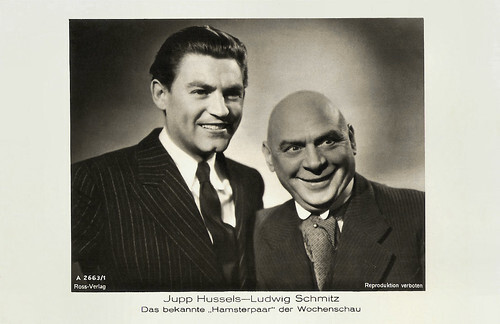
German postcard by Ross Verlag, no. A 2663/1, 1939-1940. Caption: The well-known "hamster couple" from the newsreel.
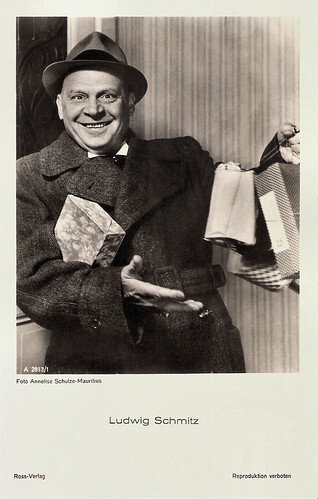
German postcard by Ross Verlag, no. A 2813/1, 1939-1940. Photo: Annelise Schulze-Mauritius.
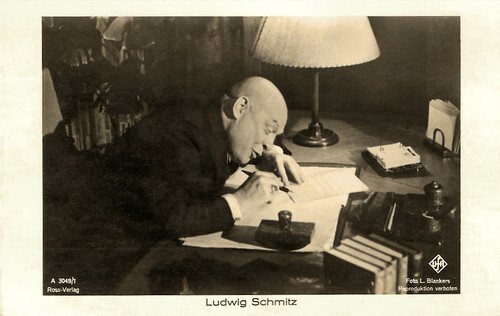
German postcard by Ross Verlag, no. A 3049/1, 1941-1944. Photo: L. Blankers / Ufa.
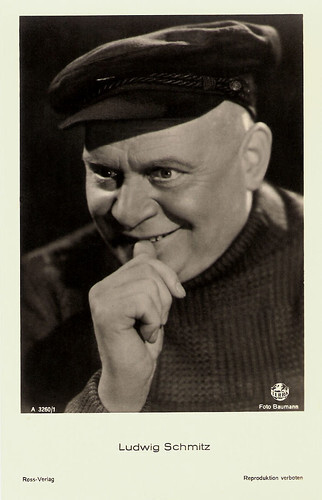
German postcard by Ross Verlag, no. A 3260/1, 1941-1944. Photo: Baumann / Terra.
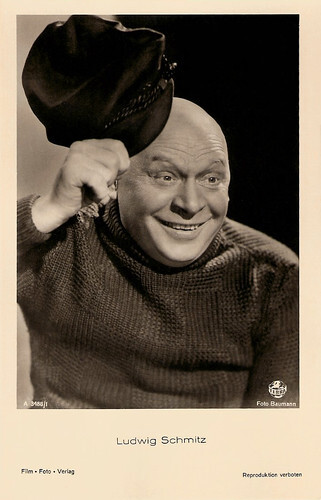
German postcard by Film-Foto-Verlag, no. A 3488/1, 1941-1944. Photo: Baumann / Terra.
Typical sense of humour
Despite having joined both the SS in 1934 and the NSDAP in 1937, Ludwig Schmitz was imposed with a working prohibition in 1941 because of "unworthy behaviour".
The only exception was his support role as Büttenredner in Veit Harlan 's melodrama Opfergang/The Great Sacrifice (Veit Harlan, 1944) starring Carl Raddatz and Kristina Söderbaum .
After the war, Ludwig Schmitz could not make a comeback until 1950. Then he went on from his earlier successes and entertained the public with his typical sense of humour.
A big box office hit was the Heimatfilm Grün ist die Heide/The Heath Is Green (Hans Deppe, 1951) starring Sonja Ziemann and Rudolf Prack . From then on, he often appeared in films, including Am Brunnen vor dem Tore/At the Well in front of the Gate (Hans Wolff, 1952) starring Sonja Ziemann , and Der keusche Josef/The Chaste Joseph (Carl Boese, 1953) with Waltraut Haas .
In 1954, Ludwig Schmitz died of a heart attack in Münster, North Rhine-Westphalia, Germany. He was 70. Schmitz was buried in the Lauheide forest cemetery near Telgte.
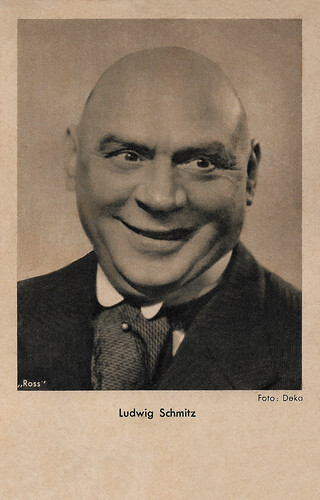
German postcard by Ross. Photo: Deka.
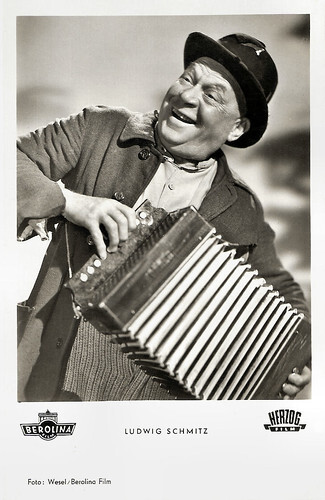
West German postcard by Kunst und Bild, Berlin, no. A 67. Photo: Wesel / Berolina Film / Herzog Film. Ludwig Schmitz in Am Brunnen vor dem Tore/At the Well in front of the Gate (Hans Wolff, 1952).
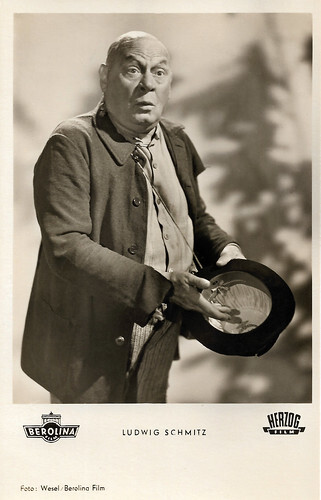
West-German postcard by Kunst und Bild, Berlin, no. A 678. Photo: Wesel / Berolina / Herzog Film. Ludwig Schmitz in Am Brunnen vor dem Tore/At the Well in front of the Gate (Hans Wolff, 1952).
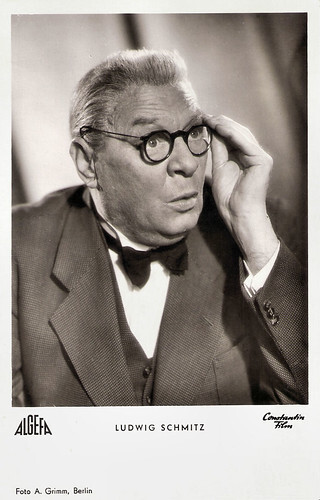
West German postcard by Kunst und Bild, Berlin, no. A 810. Photo: Arthur Grimm, Berlin / Algefa / Constantin Film. Ludwig Schmitz in Der keusche Josef/The chaste Joseph (Carl Boese, 1953).
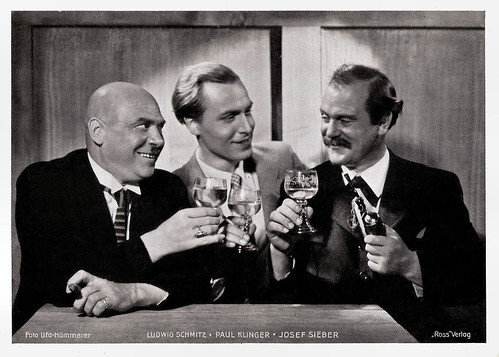
German card by Ross Verlag. Photo: Ufa / Hämmerer. Ludwig Schmitz, Paul Klinger and Josef Sieber in Das Verlegenheitskind/The embarrassment child (Peter Paul Brauer, 1938).
Sources: Wikipedia (German and English) and .

German postcard by Ross Verlag, no A 2710/1, 1939-1940. Photo: Quick / Ufa.

German postcard by Ross Verlag, no. A 2748/1, 1939-1940. Photo: Annelise Schulze-Mauritius.

German postcard by Ross Verlag, no. A 3104/1, 1941-1944. Photo: Bavaria-Filmkunst. Ludwig Schmitz in Komödianten/The Comedians (G.W. Pabst, 1941).
A contribution to the Wochenschau
Ludwig Joseph Schmitz was born in 1884 in Cologne, North Rhine-Westphalia, Germany. He was the son of the master cap maker Joseph Schmitz and his wife Louise née Klubschewsky.
Ludwig worked in his father's business and took acting lessons on the side. He started his stage career as a teenager. Around 1900, he got his first engagement at the Stadttheater Nordhausen. Later followed engagements in Mannheim, Düsseldorf, Münster and Munich, where he normally played funny roles.
He was also used as comic support in German films of the 1930s. He made his film debut with the Nazi Propaganda film Um das Menschenrecht/For the Rights of Man (Hans Zöberlein, Ludwig Schmid-Wildy, 1934).
In the following years, he played supporting parts in such entertainment films as Der ahnungslose Engel/The unsuspecting angel (Franz Seitz, 1935) starring Joe Stöckel and Lucie English and Urlaub auf Ehrenwort/Furlough on Parole (Karl Ritter, 1937). He was regarded as a typical representative of Cologne humour.
At the same time, he continued his theatre career and got involved in the Wehrmacht request program. From 1937 Schmitz worked mainly at Berlin theatres. In the years 1939 and 1940, he and Jupp Hussels played the pair "Tran und Helle" in countless short films which were shown as a contribution to the Wochenschau.

German postcard by Ross Verlag, no. A 2663/1, 1939-1940. Caption: The well-known "hamster couple" from the newsreel.

German postcard by Ross Verlag, no. A 2813/1, 1939-1940. Photo: Annelise Schulze-Mauritius.

German postcard by Ross Verlag, no. A 3049/1, 1941-1944. Photo: L. Blankers / Ufa.

German postcard by Ross Verlag, no. A 3260/1, 1941-1944. Photo: Baumann / Terra.

German postcard by Film-Foto-Verlag, no. A 3488/1, 1941-1944. Photo: Baumann / Terra.
Typical sense of humour
Despite having joined both the SS in 1934 and the NSDAP in 1937, Ludwig Schmitz was imposed with a working prohibition in 1941 because of "unworthy behaviour".
The only exception was his support role as Büttenredner in Veit Harlan 's melodrama Opfergang/The Great Sacrifice (Veit Harlan, 1944) starring Carl Raddatz and Kristina Söderbaum .
After the war, Ludwig Schmitz could not make a comeback until 1950. Then he went on from his earlier successes and entertained the public with his typical sense of humour.
A big box office hit was the Heimatfilm Grün ist die Heide/The Heath Is Green (Hans Deppe, 1951) starring Sonja Ziemann and Rudolf Prack . From then on, he often appeared in films, including Am Brunnen vor dem Tore/At the Well in front of the Gate (Hans Wolff, 1952) starring Sonja Ziemann , and Der keusche Josef/The Chaste Joseph (Carl Boese, 1953) with Waltraut Haas .
In 1954, Ludwig Schmitz died of a heart attack in Münster, North Rhine-Westphalia, Germany. He was 70. Schmitz was buried in the Lauheide forest cemetery near Telgte.

German postcard by Ross. Photo: Deka.

West German postcard by Kunst und Bild, Berlin, no. A 67. Photo: Wesel / Berolina Film / Herzog Film. Ludwig Schmitz in Am Brunnen vor dem Tore/At the Well in front of the Gate (Hans Wolff, 1952).

West-German postcard by Kunst und Bild, Berlin, no. A 678. Photo: Wesel / Berolina / Herzog Film. Ludwig Schmitz in Am Brunnen vor dem Tore/At the Well in front of the Gate (Hans Wolff, 1952).

West German postcard by Kunst und Bild, Berlin, no. A 810. Photo: Arthur Grimm, Berlin / Algefa / Constantin Film. Ludwig Schmitz in Der keusche Josef/The chaste Joseph (Carl Boese, 1953).

German card by Ross Verlag. Photo: Ufa / Hämmerer. Ludwig Schmitz, Paul Klinger and Josef Sieber in Das Verlegenheitskind/The embarrassment child (Peter Paul Brauer, 1938).
Sources: Wikipedia (German and English) and .
Published on August 12, 2023 22:00
August 11, 2023
Directed by Howard Hawks
Director Howard Hawks (1896-1977) was one of the most celebrated American filmmakers. Ironically, he was little celebrated by his peers in the Academy of Motion Picture Arts and Sciences during his career. Hawks never won an Oscar in competition and was nominated for Best Director only for Sergeant York (1941). It took the French Cahiers du Cinema critics to teach America to appreciate one of its own masters and in 1974 Hawks finally received an honorary Academy Award.
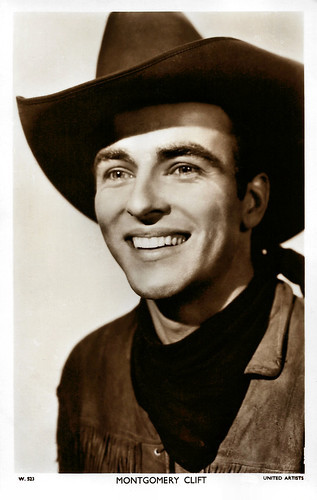
British postcard in the Picturegoer Series, London, no. W 523. Photo: United Artists. Montgomery Clift in Red River (Howard Hawks, 1948).
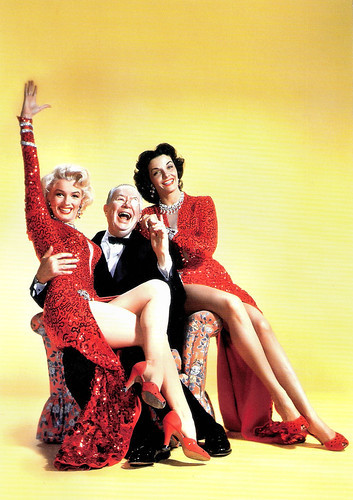
Italian programme card for Il Cinema Ritrovata 2011. Photo: publicity still for Gentlemen Prefer Blondes (Howard Hawks, 1953) with Marilyn Monroe , Charles Coburn and Jane Russell .
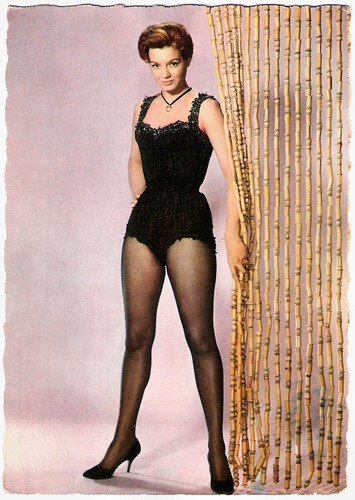
French postcard by E.D.U.G., no. 51. Angie Dickinson in Rio Bravo (Howard Hawks, 1959).
A job as a prop man at Famous Players-Lasky
Howard Hawks' career spanned the freewheeling days of the original independents in the 1910s, through the studio system in Hollywood from the silent era through the talkies, lasting into the early 1970s with the death of the studios and the emergence of the director as auteur, the latter a phenomenon that Hawks himself directly influenced.
He was born Howard Winchester Hawks in Goshen, Indiana, in 1896. He was the first child of Franklin Winchester Hawks and his wife, the former Helen Brown Howard. The day of his birth the local sheriff killed a brawler at the town saloon; the young Hawks was not born on the wild side of town, though, but with the proverbial silver spoon firmly clenched in his young mouth. His wealthy father was a member of Goshen's most prominent family, owner of the Goshen Milling Co. and many other businesses, and his maternal grandfather was one of Wisconsin's leading industrialists.
His father's family had arrived in America in 1630, while his mother's father, C.W. Howard, who was born in Maine in 1845 to parents who emigrated to the U.S. from the Isle of Man, made his fortune in the paper industry with his Howard Paper Co. Ironically, almost a half-year after Howard's birth, the first motion picture was shown in Goshen, just before Christmas on 10 December 1896. Billed as "the scientific wonder of the world," the movie played to a sold-out crowd at the Irwin Theater. However, it disappointed the audience, and attendance fell off at subsequent showings. The interest of the boy raised a Presbyterian would not be piqued again until his family moved to southern California.
The Hawks family relocated from Goshen to Neenah, Wisconsin when Howard's father was appointed secretary/treasurer of the Howard Paper Co. in 1898. Brother Kenneth Hawks was born in 1898 and was looked after by young Howard. However, Howard resented the birth of the family's next son, William B. Hawks, in 1902, and offered to sell him to a family friend for ten cents. A sister, Grace, followed William. Childbirth took a heavy toll on Howard's mother, and she never quite recovered after delivering her fifth child, Helen, in 1906. In order to aid her recovery, the family moved to the more salubrious climate of Pasadena, California, northeast of Los Angeles, for the winter of 1906-1907. The family returned to Wisconsin for the summers, but by 1910 they permanently resettled in California.
Hawks was sent to Philips Exeter Academy in Exeter, New Hampshire, for his education, and upon graduation attended Cornell University, where he majored in mechanical engineering. In both his personal and professional lives Hawks was a risk-taker and enjoyed racing airplanes and automobiles, two sports that he first indulged in his teens with his grandfather's blessing. The Los Angeles area quickly evolved into the centre of the American film industry when studios began relocating their production facilities from the New York City area to southern California in the middle of the 1910s. During one summer vacation, while Howard was matriculating at Cornell, a friend got him a job as a prop man at Famous Players-Lasky (later Paramount Pictures), and he quickly rose through the ranks.
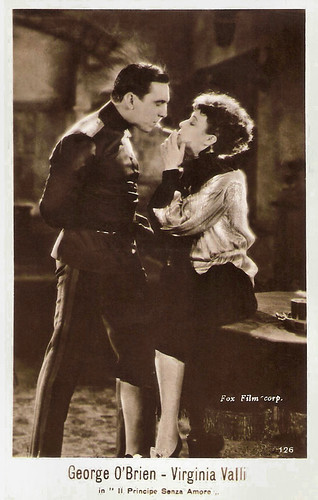
Italian postcard by G.B. Falci, Milano, no. 126. Photo: Fox Film Corp. George O'Brien and Virginia Valli in Paid to Love (Howard Hawks, 1927).
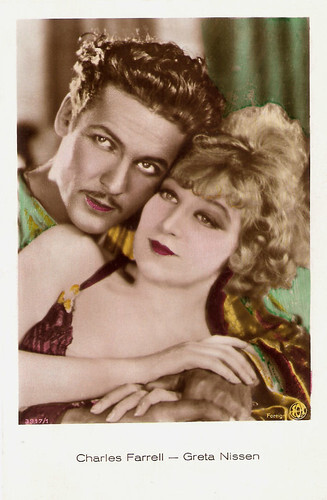
British postcard by Ross Verlag, no. 3917/1, 1928-1929. Photo: Fox. Greta Nissen and Charles Farrell in Fazil (Howard Hawks, 1928).
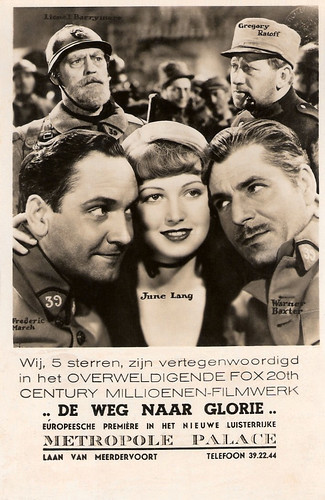
Dutch postcard for Metropole Palace, Den Haag (The Hague). Photos: 20th Century Fox. Fredric March , June Lang, Warner Baxter, Lionel Barrymore, and Gregory Ratoff in The Road to Glory (Howard Hawks, 1936). Caption: We, 5 stars, are represented in the overwhelming Fox 20th Century millions-film work The Way to Glory. European premiere in the new glorious Metropole Palace, Laan van Meerdervoort, telephone 39.22.44.
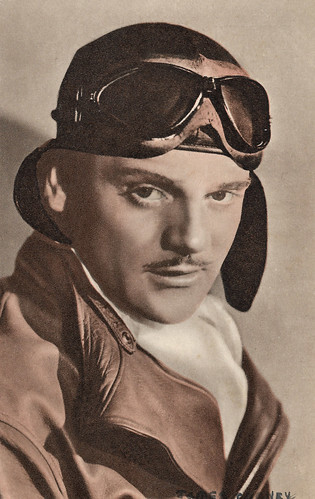
British postcard in the A Real Photogravure Portrait series. Photo: James Cagney in Ceiling Zero (Howard Hawks, 1936). Caption: James Cagney managed to support his family as a dancer and singer. This very keen athlete and boxer was discovered on the New York stage by a film scout and sent to Hollywood. His latest pictures are Frisco Kid and Ceiling Zero.
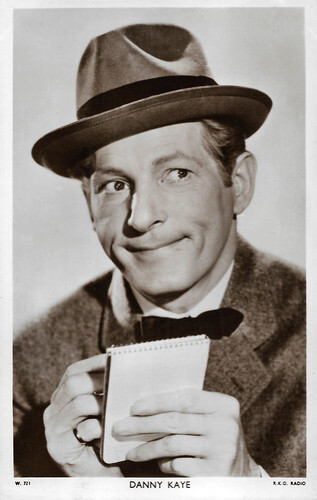
British postcard in the Picturegoer Series, London, no. W 721. Photo: RKO Radio. Danny Kaye in A Song Is Born (Howard Hawks, 1948).
Under the aegis of the eccentric multi-millionaire Howard Hughes
Howard Hawks eventually decided on a career in Hollywood and was employed in a variety of production jobs, including assistant director, casting director, script supervisor, editor and producer. He and his brother Kenneth Hawks shot aerial footage for motion pictures, but Kenneth tragically was killed during a crash while filming. Howard was hired as a screenwriter by Paramount in 1922 and was tasked with writing 40 storylines for new films in 60 days. He bought the rights for works by such established authors as Joseph Conrad and worked, mostly uncredited, on the scripts for approximately 60 films. Hawks wanted to direct, but Paramount refused to indulge his ambition. A Fox executive did, however, and Hawks directed his first film, The Road to Glory (1926), also doubling as the screenwriter.
Hawks made a name for himself by directing eight silent films in the 1920s. Paid to Love (1927) is notable in Hawks' filmography because it was a highly stylised, experimental film. He attempted to imitate the style of German film director F. W. Murnau . Hawks's film includes atypical tracking shots, expressionistic lighting and stylistic film editing that was inspired by German Expressionist cinema. A Girl in Every Port (1928) is the most important film of Hawks' silent career. It is the first of his films to utilize many of the Hawksian themes and characters that would define much of his subsequent work. It was his first "love story between two men", with two men bonding over their duty, skills, and careers, who consider their friendship to be more important than their relationships with women.
His facility for language helped him to thrive with the dawn of talking pictures, and he really established himself with his first talkie in 1930, the classic World War I aviation drama The Dawn Patrol (1930). His arrival as a major director was marked by the controversial and highly popular gangster picture Scarface (1932), a thinly disguised bio of Chicago gangster Al Capone, which was made for producer Howard Hughes. His first great film, it catapulted him into the front rank of directors and remained Hawks' favourite film. Under the aegis of the eccentric multi-millionaire Hughes, it was the only movie he ever made in which he did not have to deal with studio meddling. It leavened its ultra-violence with comedy in a potent brew that has often been imitated by other directors. Though always involved in the development of the scripts of his films, Hawks was lucky to have worked with some of the best writers in the business, including his friend and fellow aviator William Faulkner. Screenwriters he collaborated with on his films included Leigh Brackett, Ben Hecht, John Huston and Billy Wilder .
Hawks often recycled storylines from previous films, such as when he jettisoned the shooting script of El Dorado (1966) during production and reworked the film-in-progress into a remake of Rio Bravo (1959). It was Hawks' directorial skills, his ability to ensure that the audience was not aware of the twice-told nature of his films, through his engendering of high-octane, heady energy that made his films move and made them classics at best and extremely enjoyable entertainments at their "worst." Hawks' genius as a director also manifested itself in the direction of his actors, his moulding of their line readings going a long way toward making his films outstanding. The dialogue in his films often was delivered at a staccato pace, and characters' lines frequently overlapped a Hawks trademark.
Jon C. Hopwood at IMDb : "The spontaneous feeling of his films and the naturalness of the interrelationships between characters were enhanced by his habit of encouraging his actors to improvise. Unlike Alfred Hitchcock , Hawks saw his lead actors as collaborators and encouraged them to be part of the creative process. He had an excellent eye for talent and was responsible for giving the first major breaks to a roster of stars, including Paul Muni , Carole Lombard (his cousin), Lauren Bacall , Montgomery Clift and James Caan. It was Hawks, and not John Ford, who turned John Wayne into a superstar, with Red River (1948). He proceeded to give Wayne some of his best roles in the cavalry trilogy of Fort Apache (1948), She Wore a Yellow Ribbon (1949) and Rio Grande (1950), in which Wayne played a broad range of diverse characters."
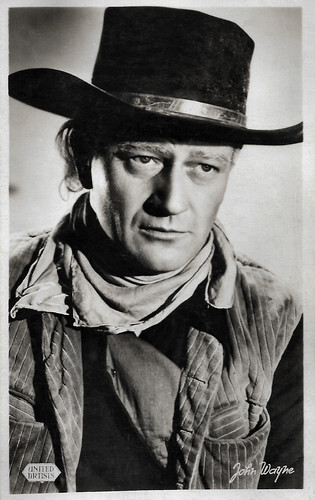
Belgian collectors card by De Beukelaere, Antwerp, no. A 11. Photo: United Artists. John Wayne in Red River (Howard Hawks, 1948).
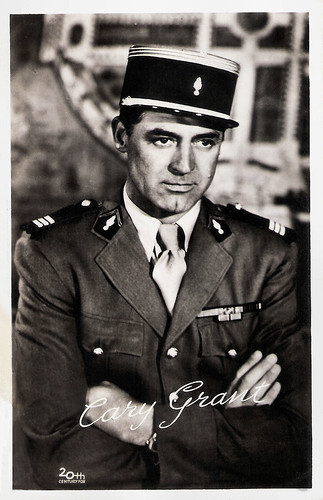
Dutch postcard, no. 3286. Photo: 20th Century Fox. Cary Grant in I Was a Male War Bride (Howard Hawks, 1949).
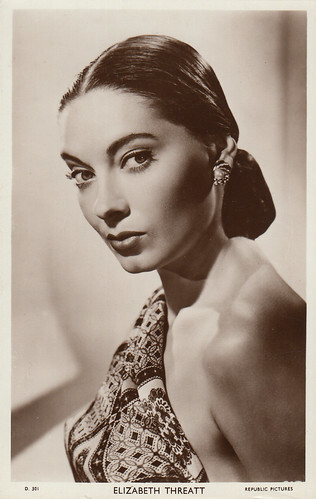
British postcard in the Picturegoer series, London, no. D 301. Elizabeth Threatt in The Big Sky (Howard Hawks, 1952). Collection: Marlene Pilaete. Comment: 'Marlene: I’m a bit puzzled by the reference to Republic Pictures on the postcard. Elizabeth Threatt’s only movie was distributed by R.K.O. and I haven’t found any mention of her being under contract to Republic. Maybe it’s a mistake.' We agree that it must be a mistake.
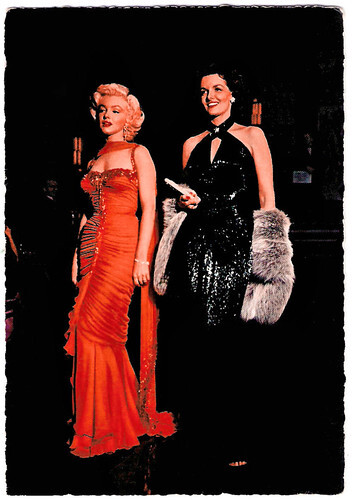
West-German postcard by Krüger, no. 902/14. Photo: Marilyn Monroe and Jane Russell in Gentlemen Prefer Blondes (Howard Hawks, 1953).
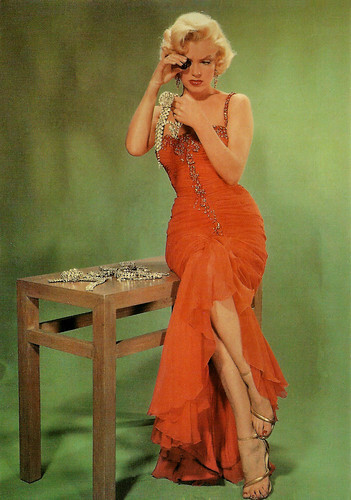
French postcard, no. Réf. Marilyn 97. Marilyn Monroe in Gentlemen Prefer Blondes (Howard Hawks, 1953).
Cary Grant in drag
During the 1930s Howard Hawks moved from hit to hit, becoming one of the most respected directors in the business. Jon C. Hopwood: "As his fame waxed, Hawks' image replaced the older, jodhpurs-and-megaphone image of the Hollywood director epitomised by Cecil B. DeMille . The new paradigm of the Hollywood director in the public eye was, like Hawks himself, tall and silver-haired, a Hemingwayesque man of action who was a thorough professional and did not fail his muse or falter in his mastery of the medium while on the job. The image of Hawks as the ultimate Hollywood professional persists to this day in Hollywood, and he continues to be a major influence on many of today's filmmakers."
Hawks was determined to remain independent and refused to attach himself to a studio, or to a particular genre, for an extended period of time. His work ethic allowed him to fit in with the production paradigms of the studio system, and he eventually worked for all eight of the major studios. A Hawks film typically focuses on a tightly bound group of professionals, often isolated from society at large, who must work together as a team if they are to survive, let alone triumph. His movies emphasize such traits as loyalty and self-respect. Air Force (1943), one of the finest propaganda films to emerge from World War II, is such a picture, in which a unit bonds aboard a B-17 bomber and the group is more than the sum of the individuals. Hawks' main theme is Hemingwayesque: the execution of one's job or duty to the best of one's ability in the face of overwhelming odds that would make an average person balk. The main characters in a Hawks film typically are people who take their jobs with the utmost seriousness, as their self-respect is rooted in their work.
In a sense, Hawks' oeuvre can be boiled down to two categories: action-adventure films and comedies. In his action-adventure movies, such as Only Angels Have Wings (1939), the male protagonist, played by Cary Grant , one of Hawks' favourite actors, is both a hero and the top dog in his social group. In the comedies, such as Bringing Up Baby (1938), Cary Grant is no hero but rather a victim of women and society. Women have only a tangential role in Hawks' action films, whereas they are the dominant figures in his comedies. Men are constantly humiliated in comedies, or are subject to role reversals like the man as the romantically hunted prey in "Baby," or the even more dramatic role reversal, including Cary Grant in drag, in I Was a Male War Bride (1949). In action-adventure films in which women are marginalized, they are forced to undergo elaborate courting rituals to attract their men, who they cannot get until they prove themselves as tough as men. There is an undercurrent of homo-eroticism to the Hawk's action films, and Hawks himself termed his A Girl in Every Port (1928) "a love story between two men." This homo-erotic leitmotif is most prominent in Red River (1948).
Hawks' films not only span a wide variety of genres but frequently rank with the best in those genres, whether the war film (The Dawn Patrol (1930)), the gangster film (Scarface ()), the Screwball comedy (His Girl Friday (1940)), the action-adventure film (Only Angels Have Wings (1939)), the Film Noir (The Big Sleep (1946)), the Western (Red River (1948) and Rio Bravo (1959)), the musical-comedy (Gentlemen Prefer Blondes (1953)) and the historical epic (Land of the Pharaohs (1955)). He even had a hand in creating one of the classic science-fiction films, The Thing from Another World (1951), which was produced by Hawks but directed by Christian Nyby, who had edited multiple Hawks films and who, in his sole directorial effort, essentially created a Hawks film.
Though Howard Hawks created some of the most memorable moments in the history of American film a half-century ago, serious critics generally eschewed his work, as they did not believe there was a controlling intelligence behind them. Seen as the consummate professional director in the industrial process that was the studio film, serious critics believed that the great moments of Hawks' films were simply accidents that accrued from working in Hollywood with other professionals. In his 1948 book 'The Film Till Now," Richard Griffin summed this feeling up with "Hawks is a very good all-rounder." Serious critics at the time attributed the mantle of "artist" to a director only when they could discern artistic aspirations, a personal visual style, or serious thematic intent. Hawks seemed to them an unambitious, commercial Hollywood director who was good enough to turn out first-rate entertainment in a wide variety of genre films in a time in which genre films such as the melodrama, the war picture and the gangster picture were treated with a lack of respect. The critical perception of Hawks began to change when the auteur theory - the idea that one intelligence was responsible for the creation of superior films regardless of their designation as "commercial" or "art house" - began to influence American film criticism. Commenting on Hawks' facility to make films in a wide variety of genres, critic Andrew Sarris, who introduced the auteur theory to American film criticism, said of Hawks, "For a major director, there are no minor genres." A Hawks genre picture is rooted in the conventions and audience expectations typical of the Hollywood genre. The Hawks genre picture does not radically challenge, undermine or overthrow either the conventions of the genre or the audience expectations of the genre film, but expands it the genre by revivifying it with new energy.
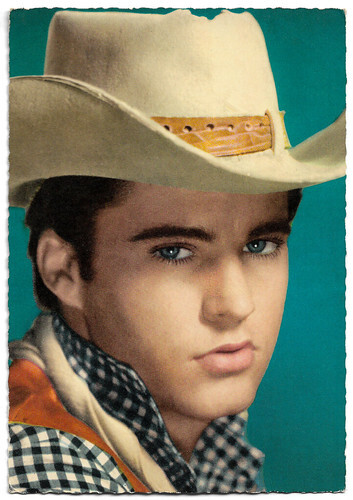
West-German postcard by ISV, no. H 65. Ricky Nelson in Rio Bravo (Howard Hawks, 1959).
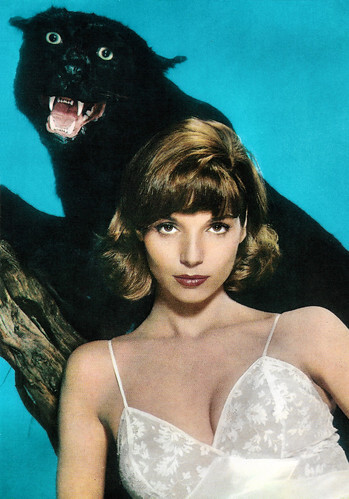
Italian postcard by Rotalcolor, Milano, no. N. 178. Photo: Warner Bros. Elsa Martinelli in Hatari! (Howard Hawks, 1962).
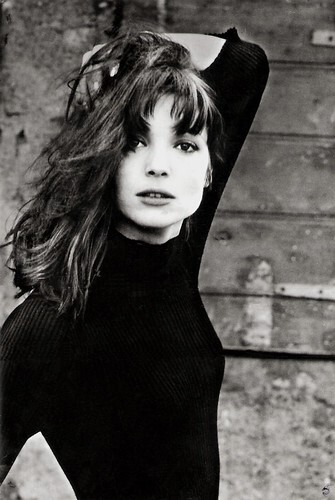
Romanian postcard by Casa Filmului Acin, no. 103. Photo: Elsa Martinelli in Hatari! (Howard Hawks, 1962).
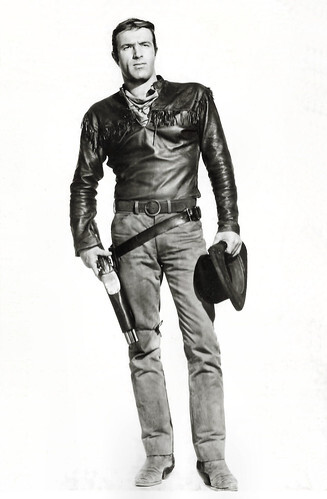
Romanian postcard by Casa Filmului Acin, no. 212. James Caan in El Dorado (Howard Hawks, 1967).
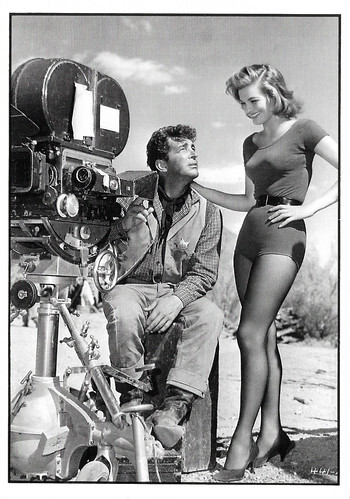
French postcard in the Entr'acte series by Éditions Asphodèle. Mâcon, no. 006/7. Collection: B. Courtel / D.R. Dean Martin and Angie Dickinson in 1958 at the set of Rio Bravo (Howard Hawks, 1959). Caption: Dean Martin and his partner Angie Dickinson behind the camera for a break.
Sources: (IMDb), Wikipedia and .

British postcard in the Picturegoer Series, London, no. W 523. Photo: United Artists. Montgomery Clift in Red River (Howard Hawks, 1948).

Italian programme card for Il Cinema Ritrovata 2011. Photo: publicity still for Gentlemen Prefer Blondes (Howard Hawks, 1953) with Marilyn Monroe , Charles Coburn and Jane Russell .

French postcard by E.D.U.G., no. 51. Angie Dickinson in Rio Bravo (Howard Hawks, 1959).
A job as a prop man at Famous Players-Lasky
Howard Hawks' career spanned the freewheeling days of the original independents in the 1910s, through the studio system in Hollywood from the silent era through the talkies, lasting into the early 1970s with the death of the studios and the emergence of the director as auteur, the latter a phenomenon that Hawks himself directly influenced.
He was born Howard Winchester Hawks in Goshen, Indiana, in 1896. He was the first child of Franklin Winchester Hawks and his wife, the former Helen Brown Howard. The day of his birth the local sheriff killed a brawler at the town saloon; the young Hawks was not born on the wild side of town, though, but with the proverbial silver spoon firmly clenched in his young mouth. His wealthy father was a member of Goshen's most prominent family, owner of the Goshen Milling Co. and many other businesses, and his maternal grandfather was one of Wisconsin's leading industrialists.
His father's family had arrived in America in 1630, while his mother's father, C.W. Howard, who was born in Maine in 1845 to parents who emigrated to the U.S. from the Isle of Man, made his fortune in the paper industry with his Howard Paper Co. Ironically, almost a half-year after Howard's birth, the first motion picture was shown in Goshen, just before Christmas on 10 December 1896. Billed as "the scientific wonder of the world," the movie played to a sold-out crowd at the Irwin Theater. However, it disappointed the audience, and attendance fell off at subsequent showings. The interest of the boy raised a Presbyterian would not be piqued again until his family moved to southern California.
The Hawks family relocated from Goshen to Neenah, Wisconsin when Howard's father was appointed secretary/treasurer of the Howard Paper Co. in 1898. Brother Kenneth Hawks was born in 1898 and was looked after by young Howard. However, Howard resented the birth of the family's next son, William B. Hawks, in 1902, and offered to sell him to a family friend for ten cents. A sister, Grace, followed William. Childbirth took a heavy toll on Howard's mother, and she never quite recovered after delivering her fifth child, Helen, in 1906. In order to aid her recovery, the family moved to the more salubrious climate of Pasadena, California, northeast of Los Angeles, for the winter of 1906-1907. The family returned to Wisconsin for the summers, but by 1910 they permanently resettled in California.
Hawks was sent to Philips Exeter Academy in Exeter, New Hampshire, for his education, and upon graduation attended Cornell University, where he majored in mechanical engineering. In both his personal and professional lives Hawks was a risk-taker and enjoyed racing airplanes and automobiles, two sports that he first indulged in his teens with his grandfather's blessing. The Los Angeles area quickly evolved into the centre of the American film industry when studios began relocating their production facilities from the New York City area to southern California in the middle of the 1910s. During one summer vacation, while Howard was matriculating at Cornell, a friend got him a job as a prop man at Famous Players-Lasky (later Paramount Pictures), and he quickly rose through the ranks.

Italian postcard by G.B. Falci, Milano, no. 126. Photo: Fox Film Corp. George O'Brien and Virginia Valli in Paid to Love (Howard Hawks, 1927).

British postcard by Ross Verlag, no. 3917/1, 1928-1929. Photo: Fox. Greta Nissen and Charles Farrell in Fazil (Howard Hawks, 1928).

Dutch postcard for Metropole Palace, Den Haag (The Hague). Photos: 20th Century Fox. Fredric March , June Lang, Warner Baxter, Lionel Barrymore, and Gregory Ratoff in The Road to Glory (Howard Hawks, 1936). Caption: We, 5 stars, are represented in the overwhelming Fox 20th Century millions-film work The Way to Glory. European premiere in the new glorious Metropole Palace, Laan van Meerdervoort, telephone 39.22.44.

British postcard in the A Real Photogravure Portrait series. Photo: James Cagney in Ceiling Zero (Howard Hawks, 1936). Caption: James Cagney managed to support his family as a dancer and singer. This very keen athlete and boxer was discovered on the New York stage by a film scout and sent to Hollywood. His latest pictures are Frisco Kid and Ceiling Zero.

British postcard in the Picturegoer Series, London, no. W 721. Photo: RKO Radio. Danny Kaye in A Song Is Born (Howard Hawks, 1948).
Under the aegis of the eccentric multi-millionaire Howard Hughes
Howard Hawks eventually decided on a career in Hollywood and was employed in a variety of production jobs, including assistant director, casting director, script supervisor, editor and producer. He and his brother Kenneth Hawks shot aerial footage for motion pictures, but Kenneth tragically was killed during a crash while filming. Howard was hired as a screenwriter by Paramount in 1922 and was tasked with writing 40 storylines for new films in 60 days. He bought the rights for works by such established authors as Joseph Conrad and worked, mostly uncredited, on the scripts for approximately 60 films. Hawks wanted to direct, but Paramount refused to indulge his ambition. A Fox executive did, however, and Hawks directed his first film, The Road to Glory (1926), also doubling as the screenwriter.
Hawks made a name for himself by directing eight silent films in the 1920s. Paid to Love (1927) is notable in Hawks' filmography because it was a highly stylised, experimental film. He attempted to imitate the style of German film director F. W. Murnau . Hawks's film includes atypical tracking shots, expressionistic lighting and stylistic film editing that was inspired by German Expressionist cinema. A Girl in Every Port (1928) is the most important film of Hawks' silent career. It is the first of his films to utilize many of the Hawksian themes and characters that would define much of his subsequent work. It was his first "love story between two men", with two men bonding over their duty, skills, and careers, who consider their friendship to be more important than their relationships with women.
His facility for language helped him to thrive with the dawn of talking pictures, and he really established himself with his first talkie in 1930, the classic World War I aviation drama The Dawn Patrol (1930). His arrival as a major director was marked by the controversial and highly popular gangster picture Scarface (1932), a thinly disguised bio of Chicago gangster Al Capone, which was made for producer Howard Hughes. His first great film, it catapulted him into the front rank of directors and remained Hawks' favourite film. Under the aegis of the eccentric multi-millionaire Hughes, it was the only movie he ever made in which he did not have to deal with studio meddling. It leavened its ultra-violence with comedy in a potent brew that has often been imitated by other directors. Though always involved in the development of the scripts of his films, Hawks was lucky to have worked with some of the best writers in the business, including his friend and fellow aviator William Faulkner. Screenwriters he collaborated with on his films included Leigh Brackett, Ben Hecht, John Huston and Billy Wilder .
Hawks often recycled storylines from previous films, such as when he jettisoned the shooting script of El Dorado (1966) during production and reworked the film-in-progress into a remake of Rio Bravo (1959). It was Hawks' directorial skills, his ability to ensure that the audience was not aware of the twice-told nature of his films, through his engendering of high-octane, heady energy that made his films move and made them classics at best and extremely enjoyable entertainments at their "worst." Hawks' genius as a director also manifested itself in the direction of his actors, his moulding of their line readings going a long way toward making his films outstanding. The dialogue in his films often was delivered at a staccato pace, and characters' lines frequently overlapped a Hawks trademark.
Jon C. Hopwood at IMDb : "The spontaneous feeling of his films and the naturalness of the interrelationships between characters were enhanced by his habit of encouraging his actors to improvise. Unlike Alfred Hitchcock , Hawks saw his lead actors as collaborators and encouraged them to be part of the creative process. He had an excellent eye for talent and was responsible for giving the first major breaks to a roster of stars, including Paul Muni , Carole Lombard (his cousin), Lauren Bacall , Montgomery Clift and James Caan. It was Hawks, and not John Ford, who turned John Wayne into a superstar, with Red River (1948). He proceeded to give Wayne some of his best roles in the cavalry trilogy of Fort Apache (1948), She Wore a Yellow Ribbon (1949) and Rio Grande (1950), in which Wayne played a broad range of diverse characters."

Belgian collectors card by De Beukelaere, Antwerp, no. A 11. Photo: United Artists. John Wayne in Red River (Howard Hawks, 1948).

Dutch postcard, no. 3286. Photo: 20th Century Fox. Cary Grant in I Was a Male War Bride (Howard Hawks, 1949).

British postcard in the Picturegoer series, London, no. D 301. Elizabeth Threatt in The Big Sky (Howard Hawks, 1952). Collection: Marlene Pilaete. Comment: 'Marlene: I’m a bit puzzled by the reference to Republic Pictures on the postcard. Elizabeth Threatt’s only movie was distributed by R.K.O. and I haven’t found any mention of her being under contract to Republic. Maybe it’s a mistake.' We agree that it must be a mistake.

West-German postcard by Krüger, no. 902/14. Photo: Marilyn Monroe and Jane Russell in Gentlemen Prefer Blondes (Howard Hawks, 1953).

French postcard, no. Réf. Marilyn 97. Marilyn Monroe in Gentlemen Prefer Blondes (Howard Hawks, 1953).
Cary Grant in drag
During the 1930s Howard Hawks moved from hit to hit, becoming one of the most respected directors in the business. Jon C. Hopwood: "As his fame waxed, Hawks' image replaced the older, jodhpurs-and-megaphone image of the Hollywood director epitomised by Cecil B. DeMille . The new paradigm of the Hollywood director in the public eye was, like Hawks himself, tall and silver-haired, a Hemingwayesque man of action who was a thorough professional and did not fail his muse or falter in his mastery of the medium while on the job. The image of Hawks as the ultimate Hollywood professional persists to this day in Hollywood, and he continues to be a major influence on many of today's filmmakers."
Hawks was determined to remain independent and refused to attach himself to a studio, or to a particular genre, for an extended period of time. His work ethic allowed him to fit in with the production paradigms of the studio system, and he eventually worked for all eight of the major studios. A Hawks film typically focuses on a tightly bound group of professionals, often isolated from society at large, who must work together as a team if they are to survive, let alone triumph. His movies emphasize such traits as loyalty and self-respect. Air Force (1943), one of the finest propaganda films to emerge from World War II, is such a picture, in which a unit bonds aboard a B-17 bomber and the group is more than the sum of the individuals. Hawks' main theme is Hemingwayesque: the execution of one's job or duty to the best of one's ability in the face of overwhelming odds that would make an average person balk. The main characters in a Hawks film typically are people who take their jobs with the utmost seriousness, as their self-respect is rooted in their work.
In a sense, Hawks' oeuvre can be boiled down to two categories: action-adventure films and comedies. In his action-adventure movies, such as Only Angels Have Wings (1939), the male protagonist, played by Cary Grant , one of Hawks' favourite actors, is both a hero and the top dog in his social group. In the comedies, such as Bringing Up Baby (1938), Cary Grant is no hero but rather a victim of women and society. Women have only a tangential role in Hawks' action films, whereas they are the dominant figures in his comedies. Men are constantly humiliated in comedies, or are subject to role reversals like the man as the romantically hunted prey in "Baby," or the even more dramatic role reversal, including Cary Grant in drag, in I Was a Male War Bride (1949). In action-adventure films in which women are marginalized, they are forced to undergo elaborate courting rituals to attract their men, who they cannot get until they prove themselves as tough as men. There is an undercurrent of homo-eroticism to the Hawk's action films, and Hawks himself termed his A Girl in Every Port (1928) "a love story between two men." This homo-erotic leitmotif is most prominent in Red River (1948).
Hawks' films not only span a wide variety of genres but frequently rank with the best in those genres, whether the war film (The Dawn Patrol (1930)), the gangster film (Scarface ()), the Screwball comedy (His Girl Friday (1940)), the action-adventure film (Only Angels Have Wings (1939)), the Film Noir (The Big Sleep (1946)), the Western (Red River (1948) and Rio Bravo (1959)), the musical-comedy (Gentlemen Prefer Blondes (1953)) and the historical epic (Land of the Pharaohs (1955)). He even had a hand in creating one of the classic science-fiction films, The Thing from Another World (1951), which was produced by Hawks but directed by Christian Nyby, who had edited multiple Hawks films and who, in his sole directorial effort, essentially created a Hawks film.
Though Howard Hawks created some of the most memorable moments in the history of American film a half-century ago, serious critics generally eschewed his work, as they did not believe there was a controlling intelligence behind them. Seen as the consummate professional director in the industrial process that was the studio film, serious critics believed that the great moments of Hawks' films were simply accidents that accrued from working in Hollywood with other professionals. In his 1948 book 'The Film Till Now," Richard Griffin summed this feeling up with "Hawks is a very good all-rounder." Serious critics at the time attributed the mantle of "artist" to a director only when they could discern artistic aspirations, a personal visual style, or serious thematic intent. Hawks seemed to them an unambitious, commercial Hollywood director who was good enough to turn out first-rate entertainment in a wide variety of genre films in a time in which genre films such as the melodrama, the war picture and the gangster picture were treated with a lack of respect. The critical perception of Hawks began to change when the auteur theory - the idea that one intelligence was responsible for the creation of superior films regardless of their designation as "commercial" or "art house" - began to influence American film criticism. Commenting on Hawks' facility to make films in a wide variety of genres, critic Andrew Sarris, who introduced the auteur theory to American film criticism, said of Hawks, "For a major director, there are no minor genres." A Hawks genre picture is rooted in the conventions and audience expectations typical of the Hollywood genre. The Hawks genre picture does not radically challenge, undermine or overthrow either the conventions of the genre or the audience expectations of the genre film, but expands it the genre by revivifying it with new energy.

West-German postcard by ISV, no. H 65. Ricky Nelson in Rio Bravo (Howard Hawks, 1959).

Italian postcard by Rotalcolor, Milano, no. N. 178. Photo: Warner Bros. Elsa Martinelli in Hatari! (Howard Hawks, 1962).

Romanian postcard by Casa Filmului Acin, no. 103. Photo: Elsa Martinelli in Hatari! (Howard Hawks, 1962).

Romanian postcard by Casa Filmului Acin, no. 212. James Caan in El Dorado (Howard Hawks, 1967).

French postcard in the Entr'acte series by Éditions Asphodèle. Mâcon, no. 006/7. Collection: B. Courtel / D.R. Dean Martin and Angie Dickinson in 1958 at the set of Rio Bravo (Howard Hawks, 1959). Caption: Dean Martin and his partner Angie Dickinson behind the camera for a break.
Sources: (IMDb), Wikipedia and .
Published on August 11, 2023 22:00
Paul van Yperen's Blog
- Paul van Yperen's profile
- 13 followers
Paul van Yperen isn't a Goodreads Author
(yet),
but they
do have a blog,
so here are some recent posts imported from
their feed.



